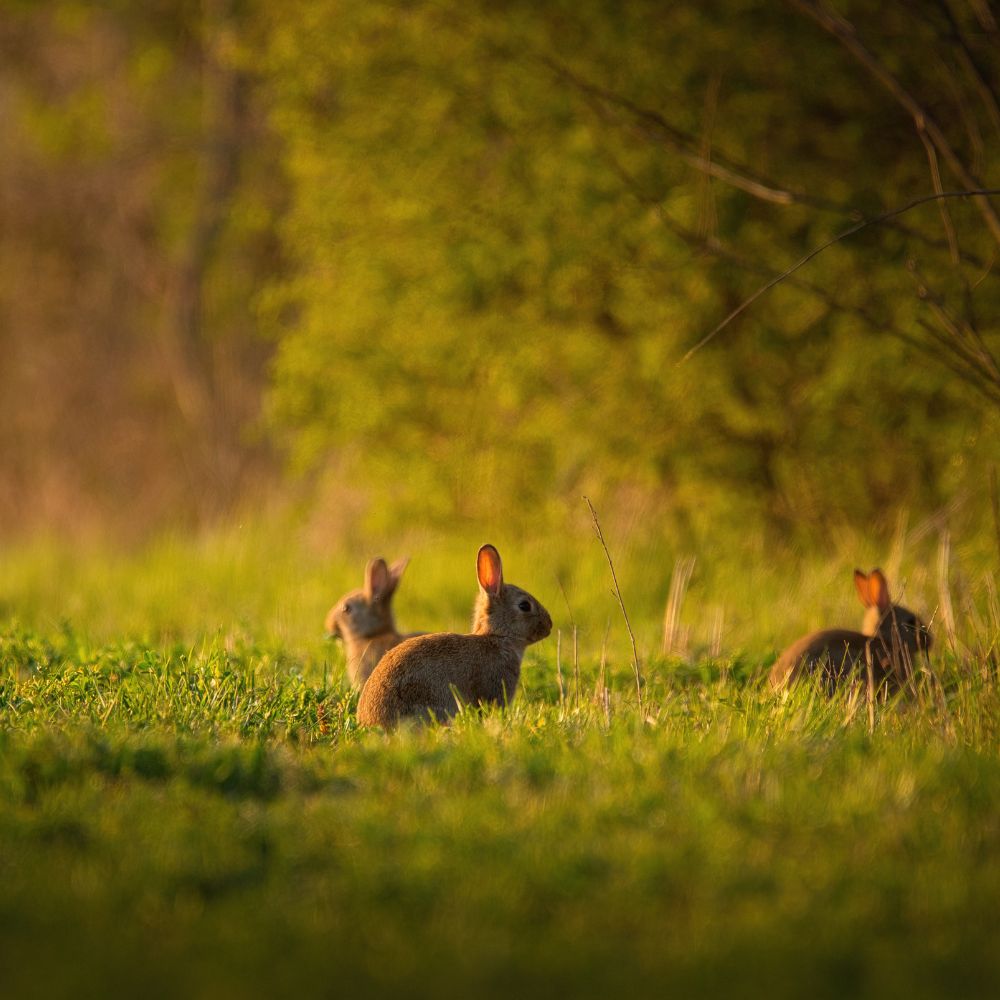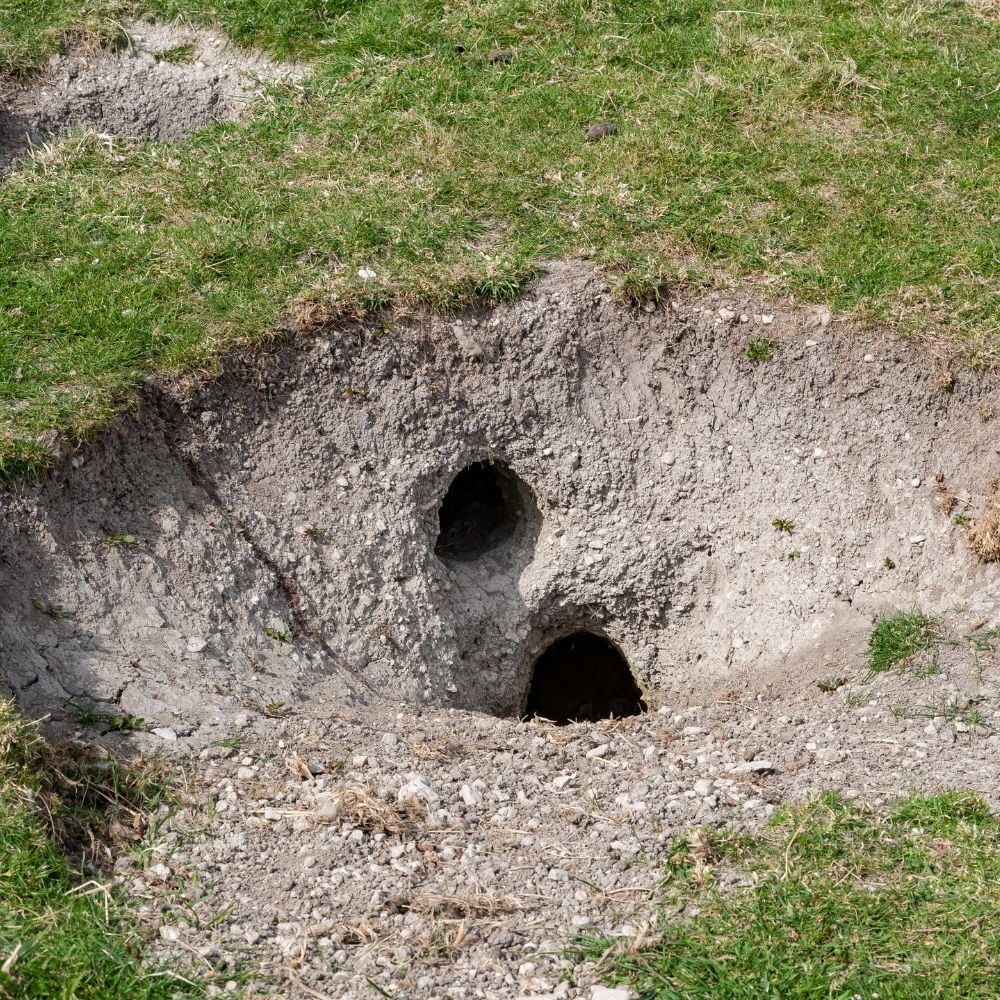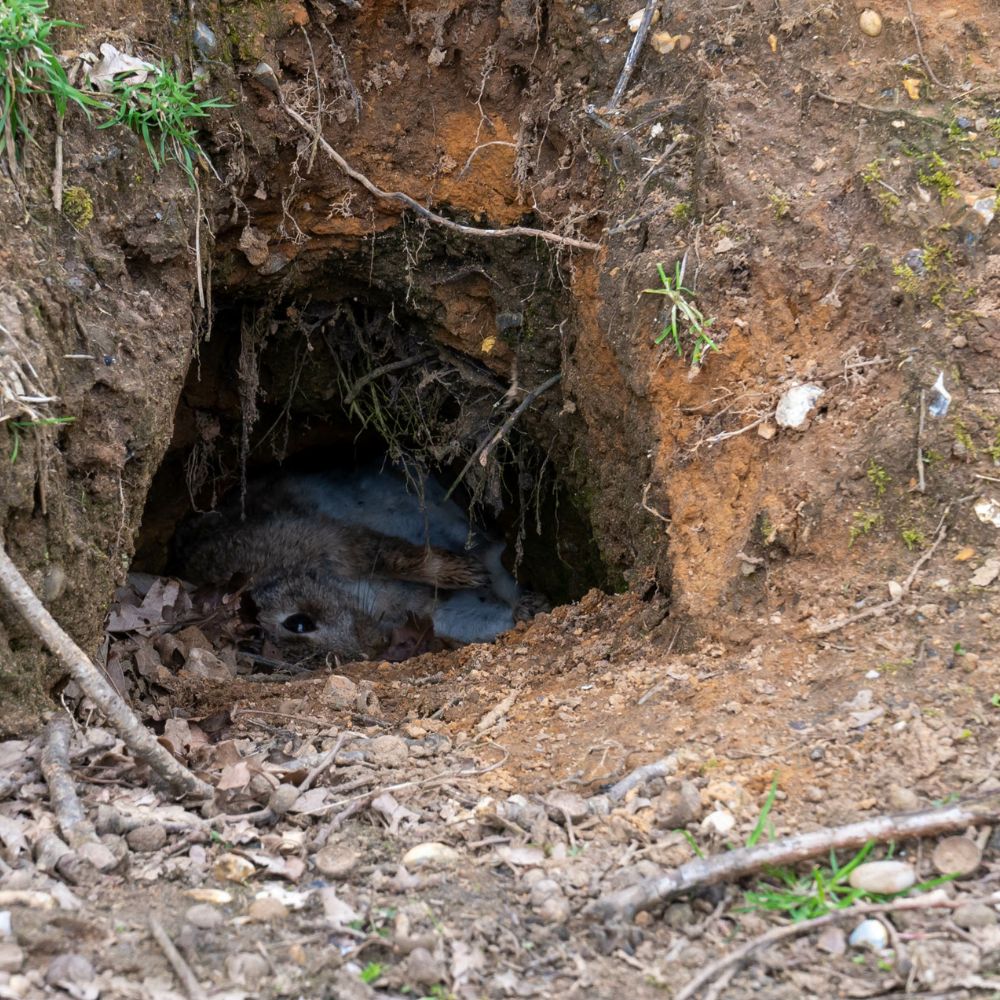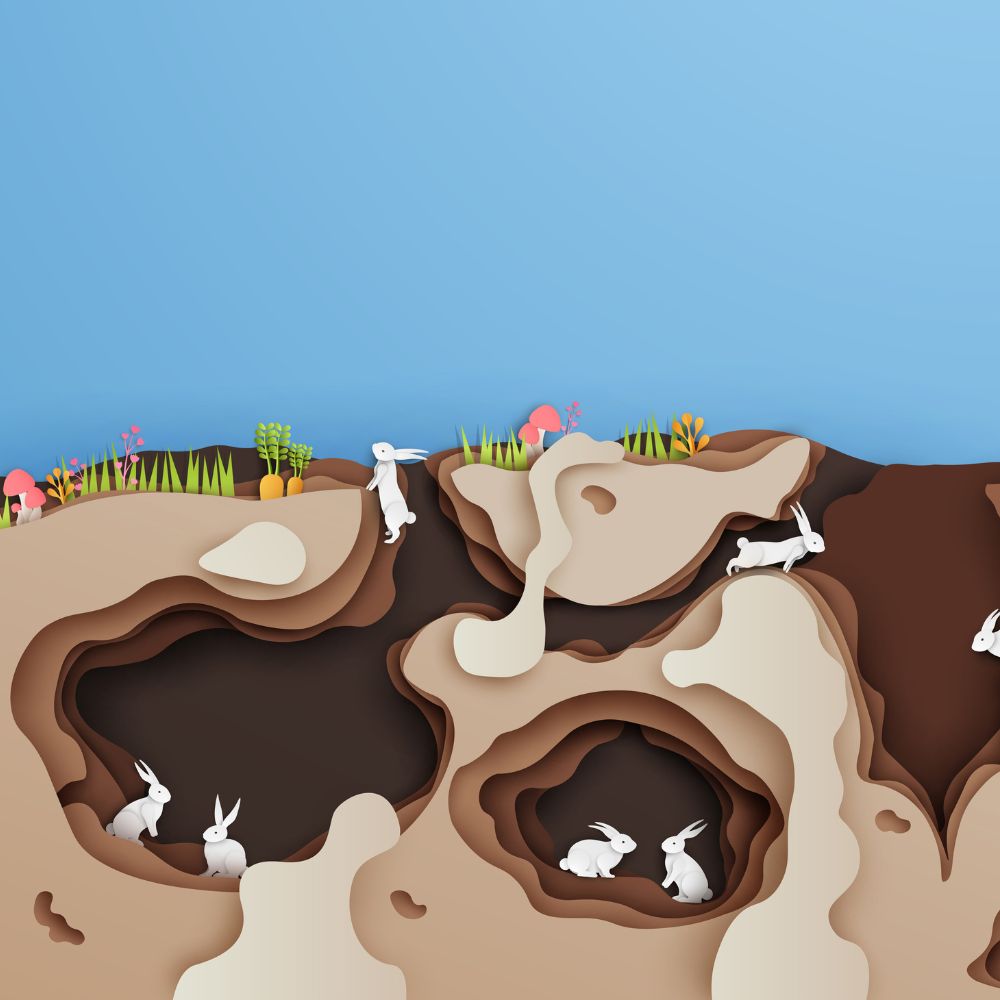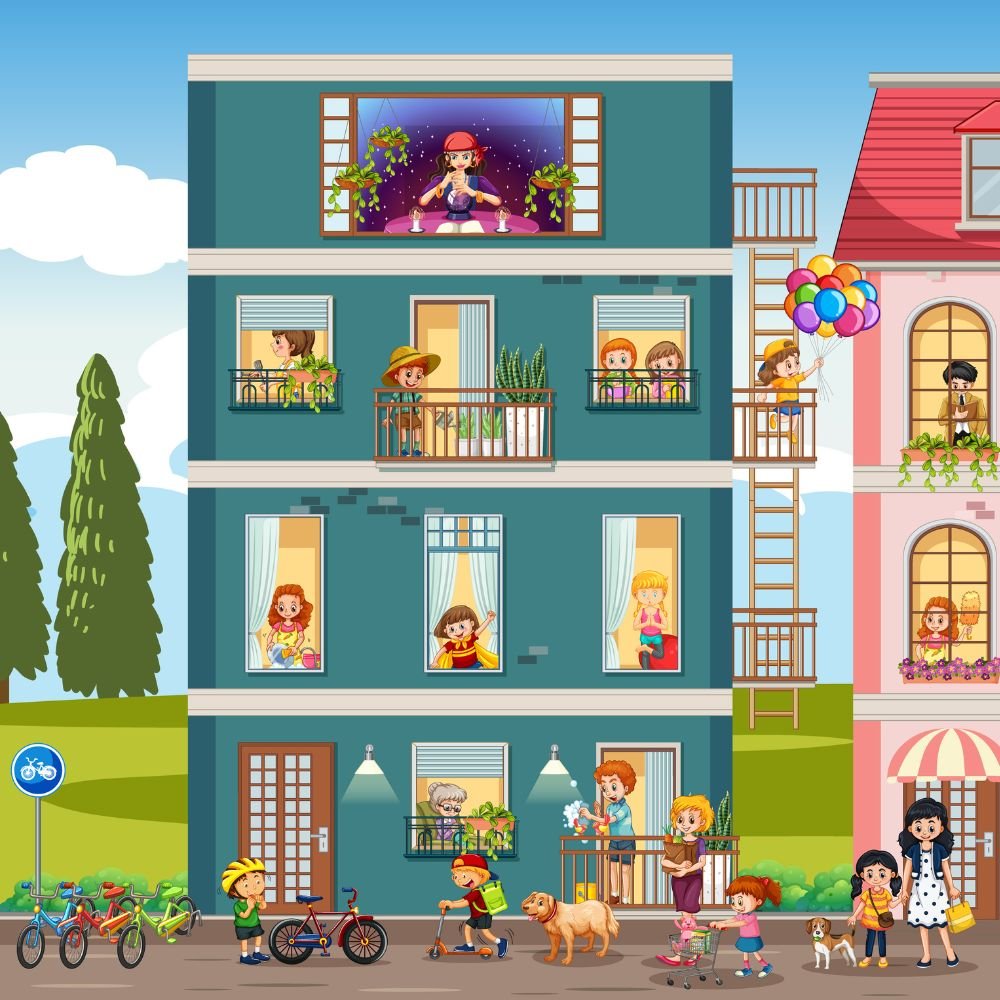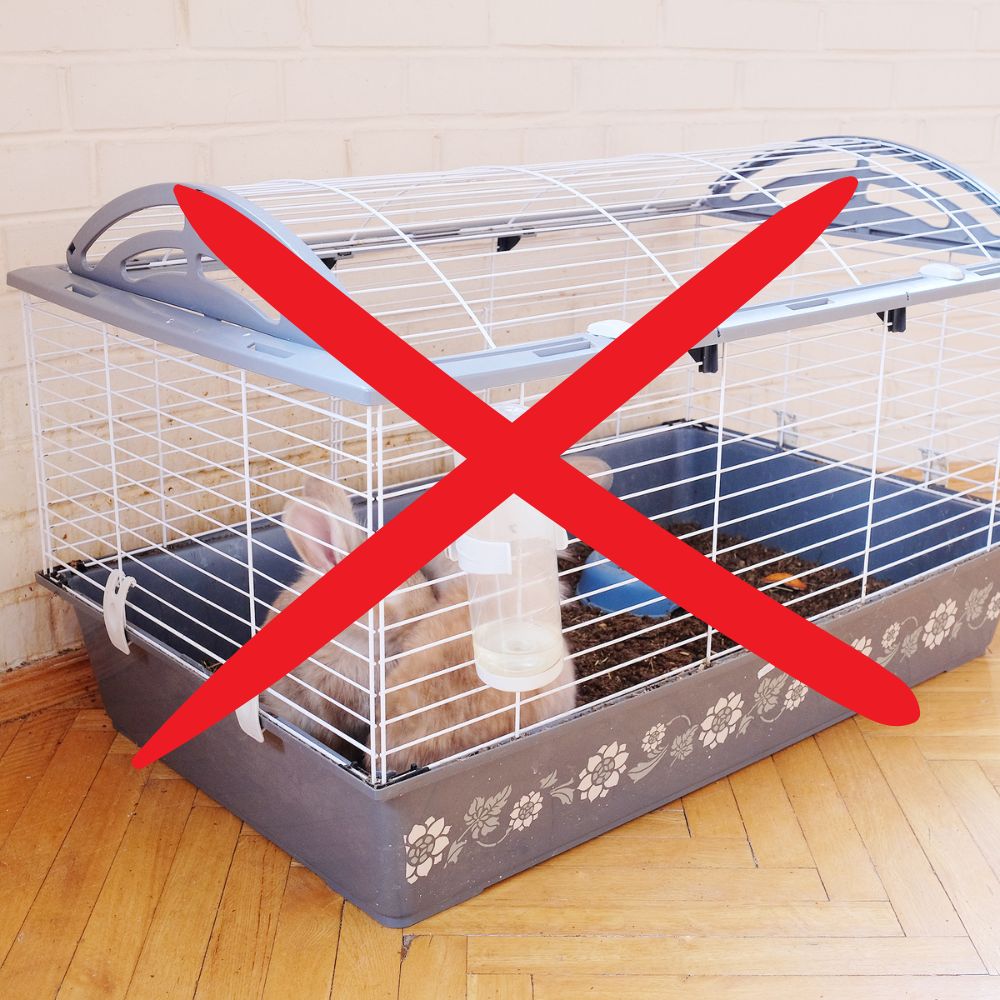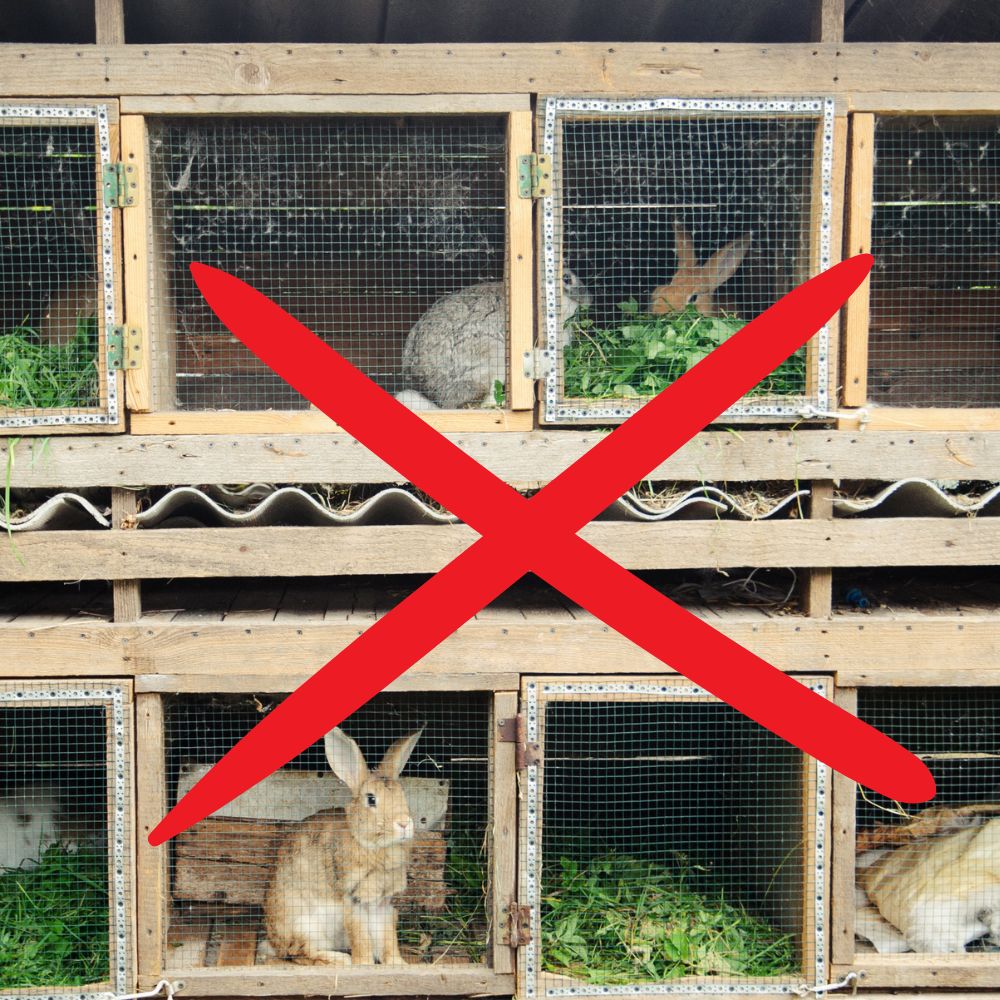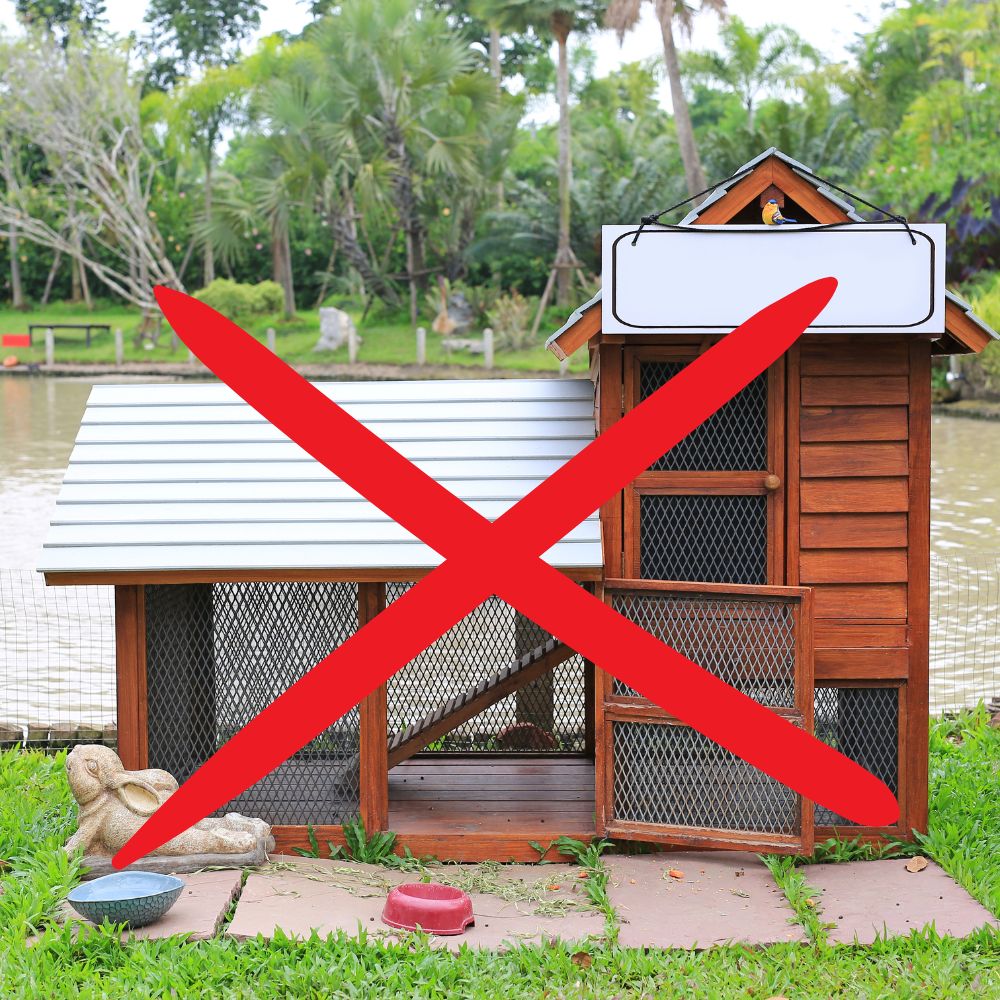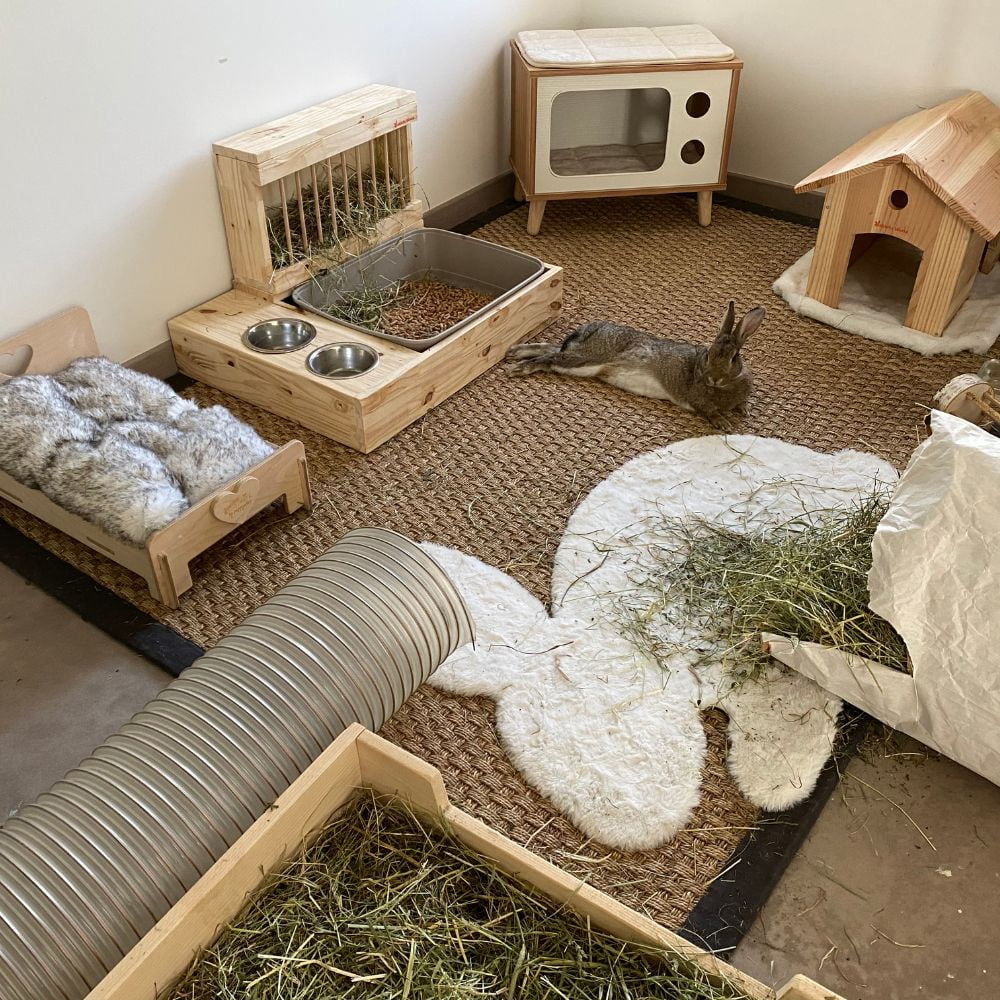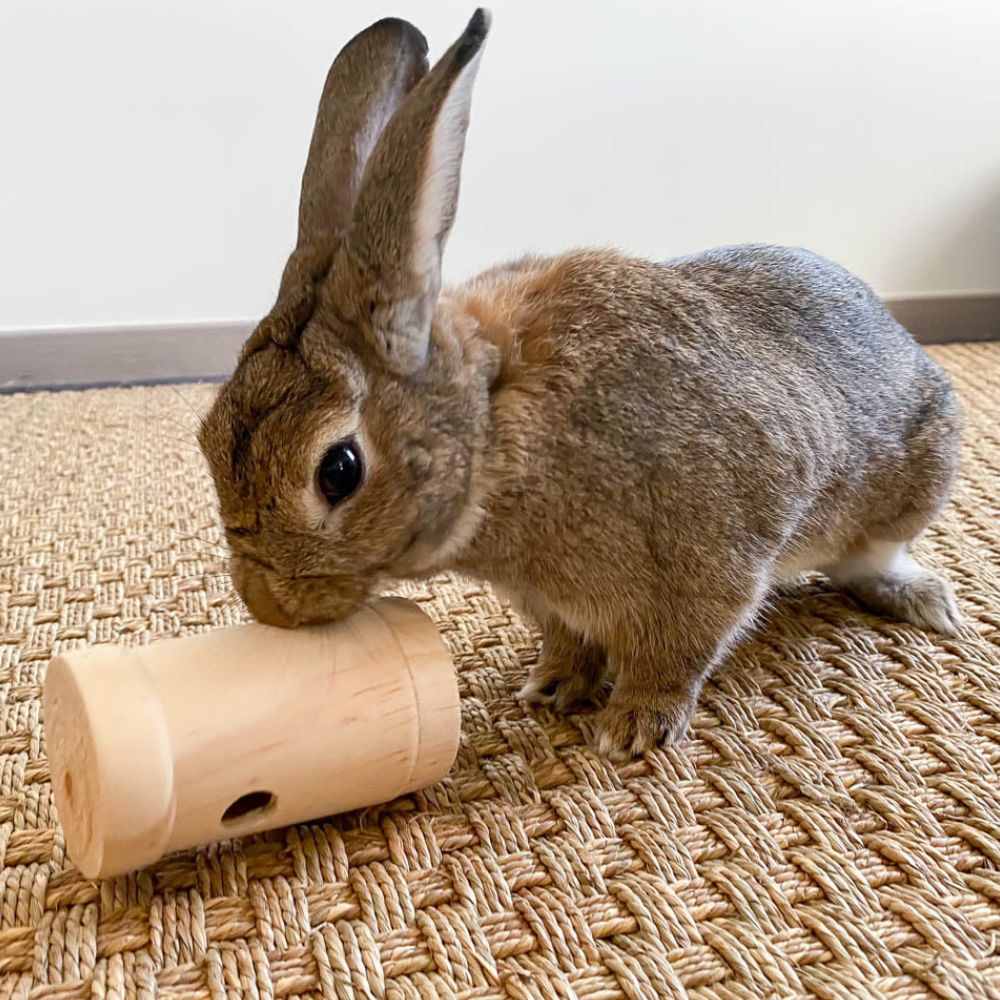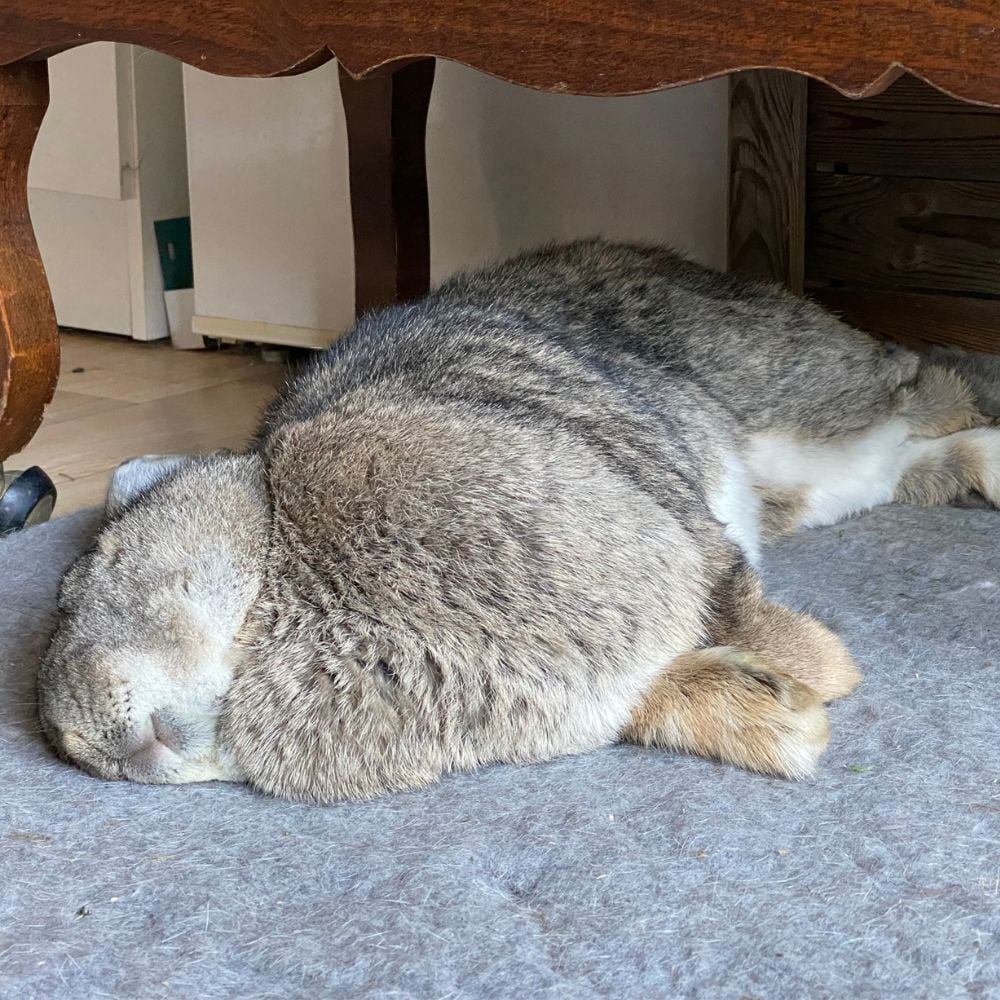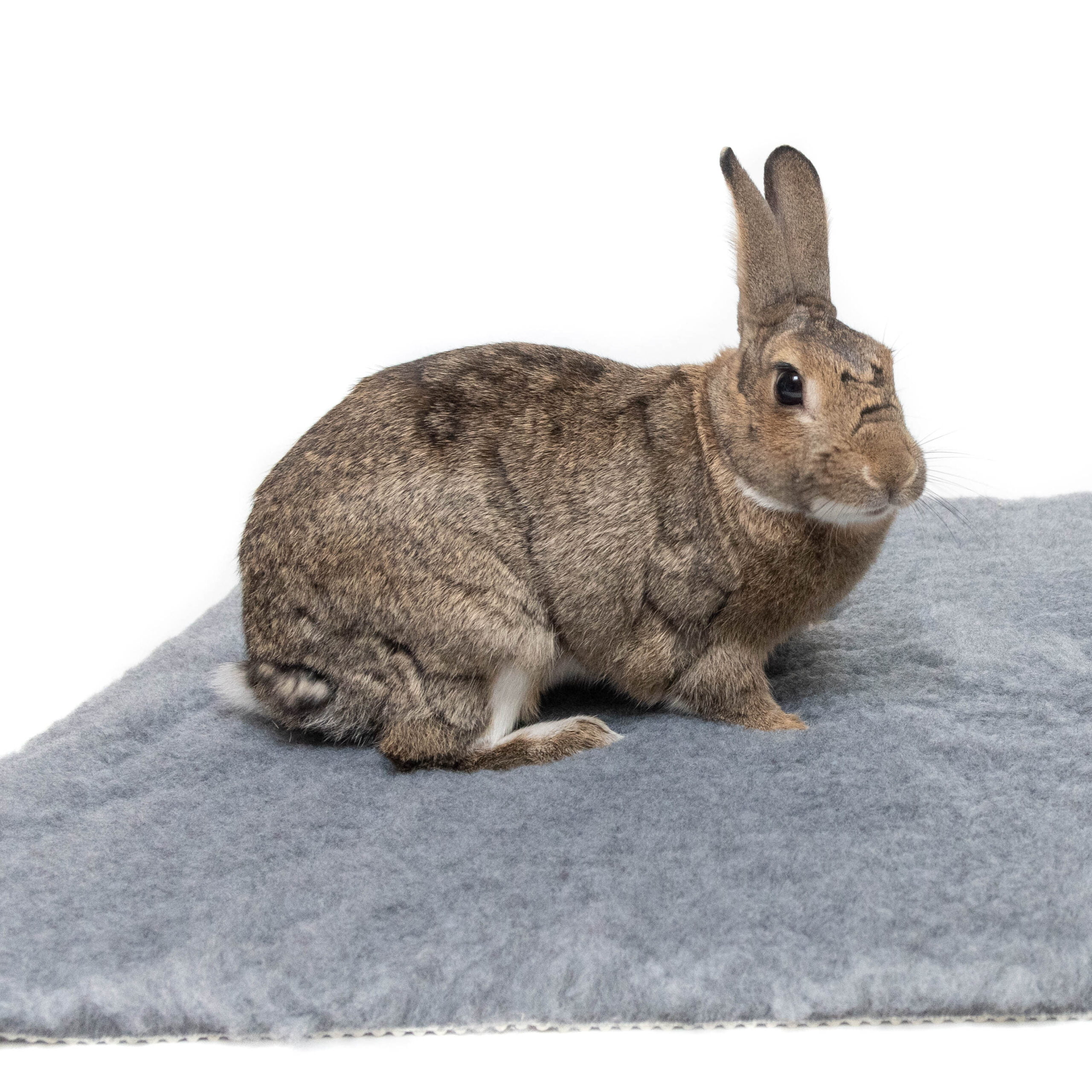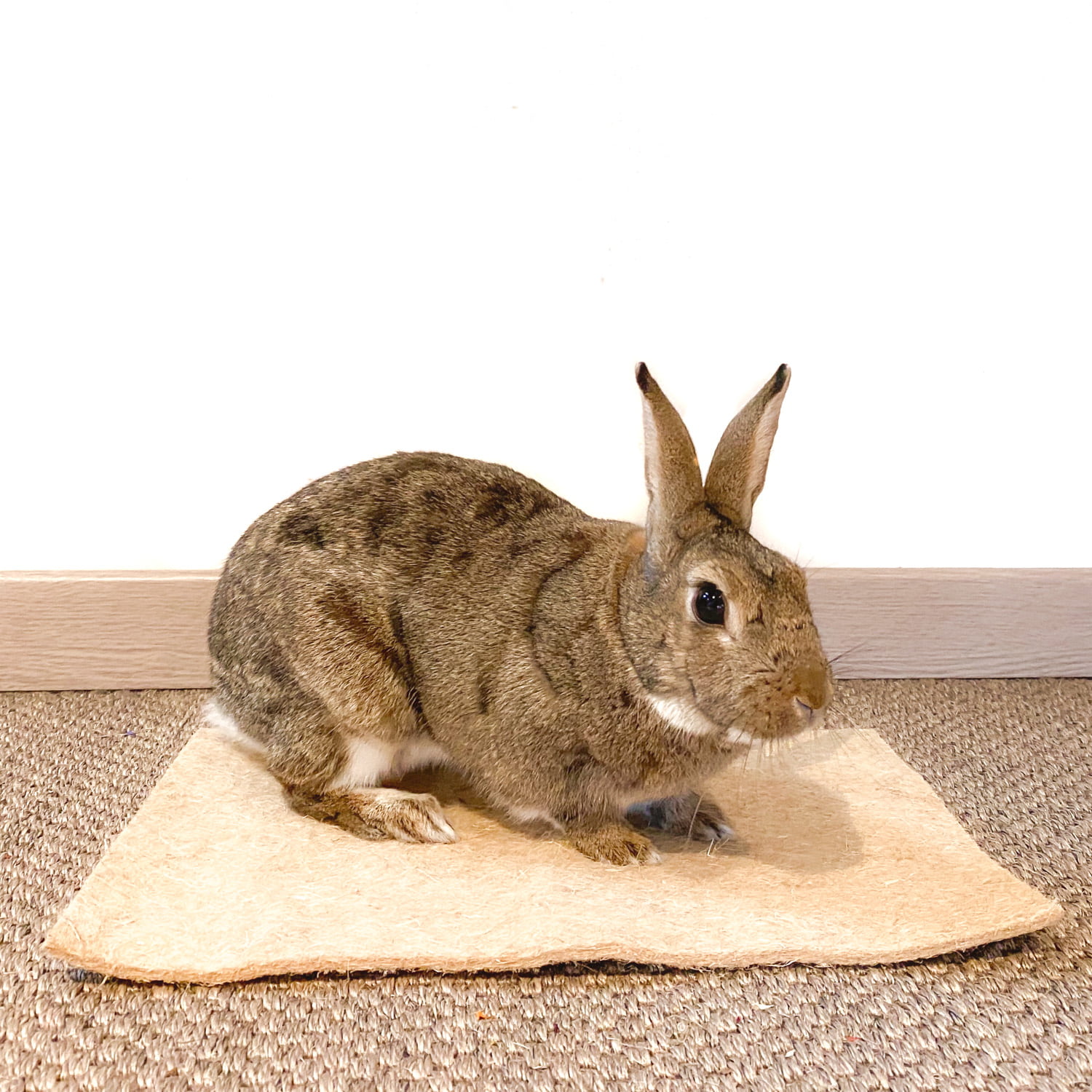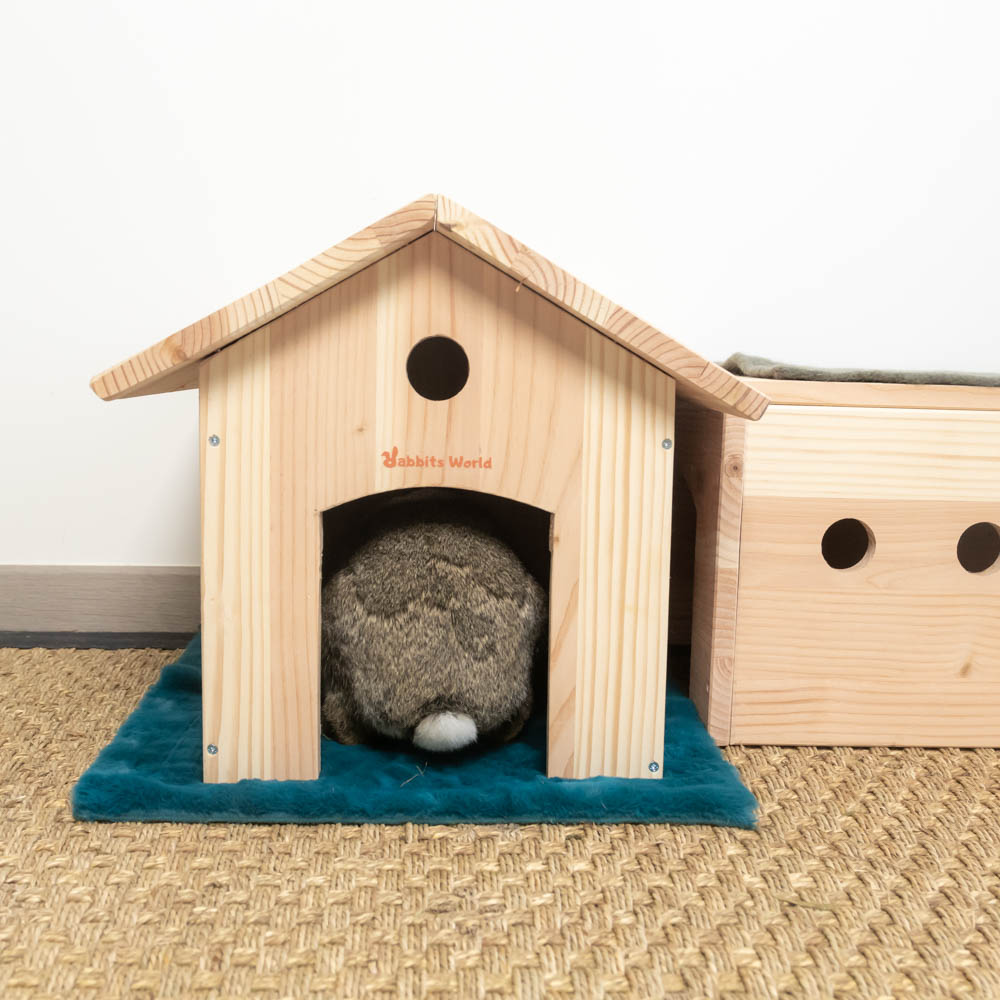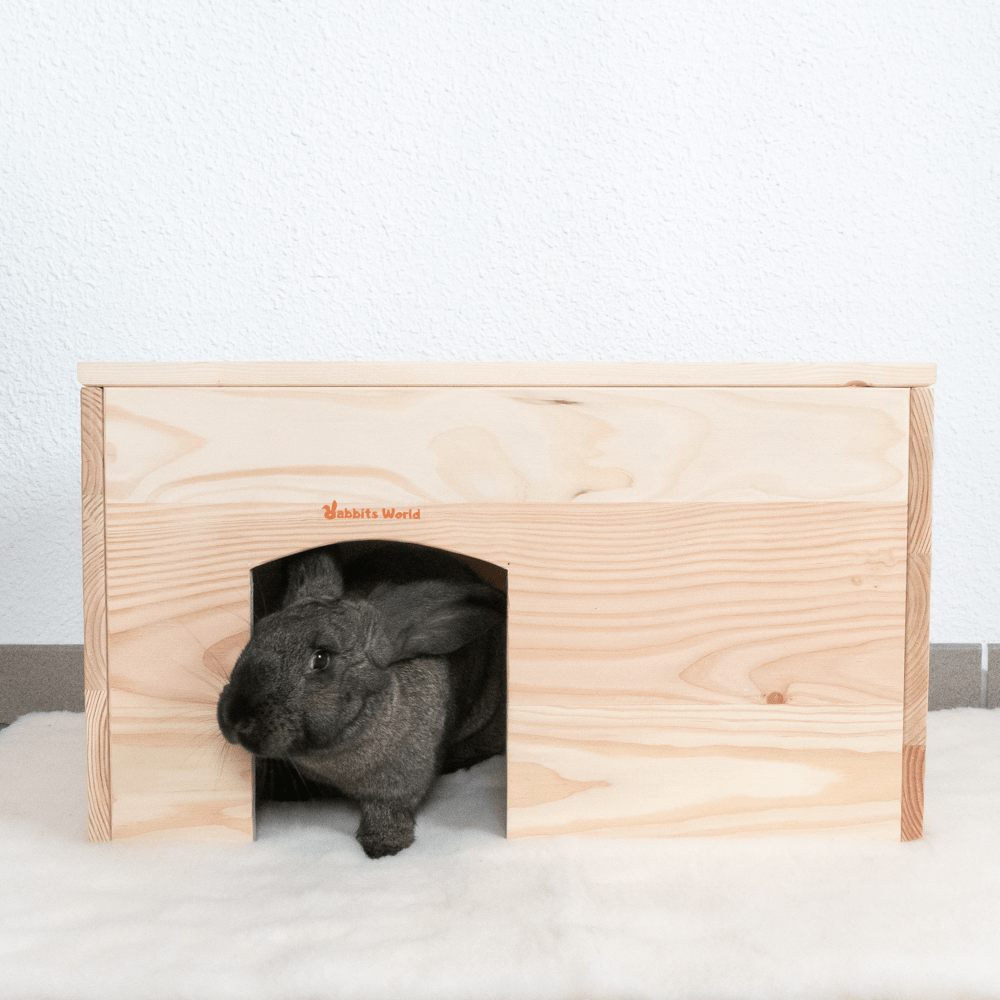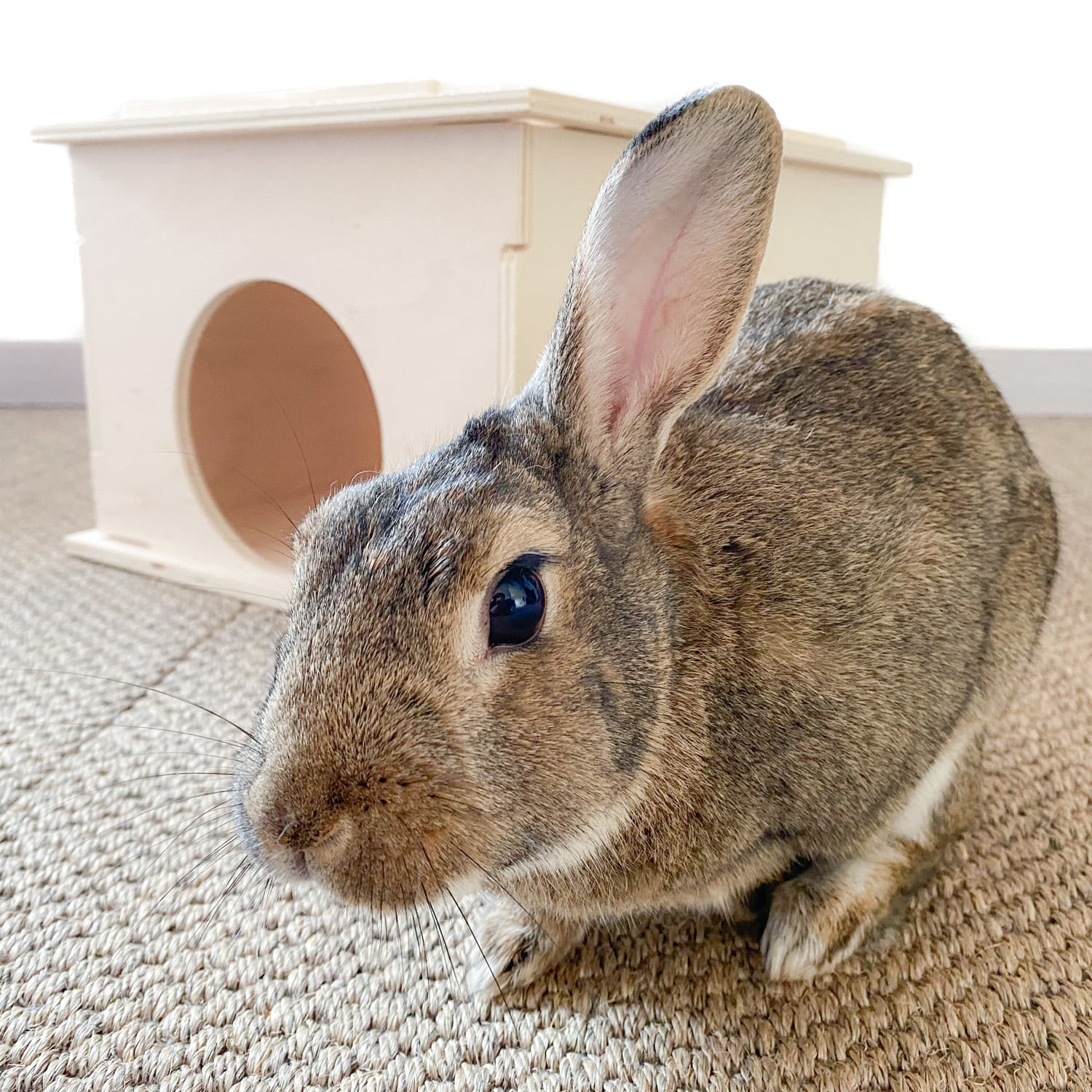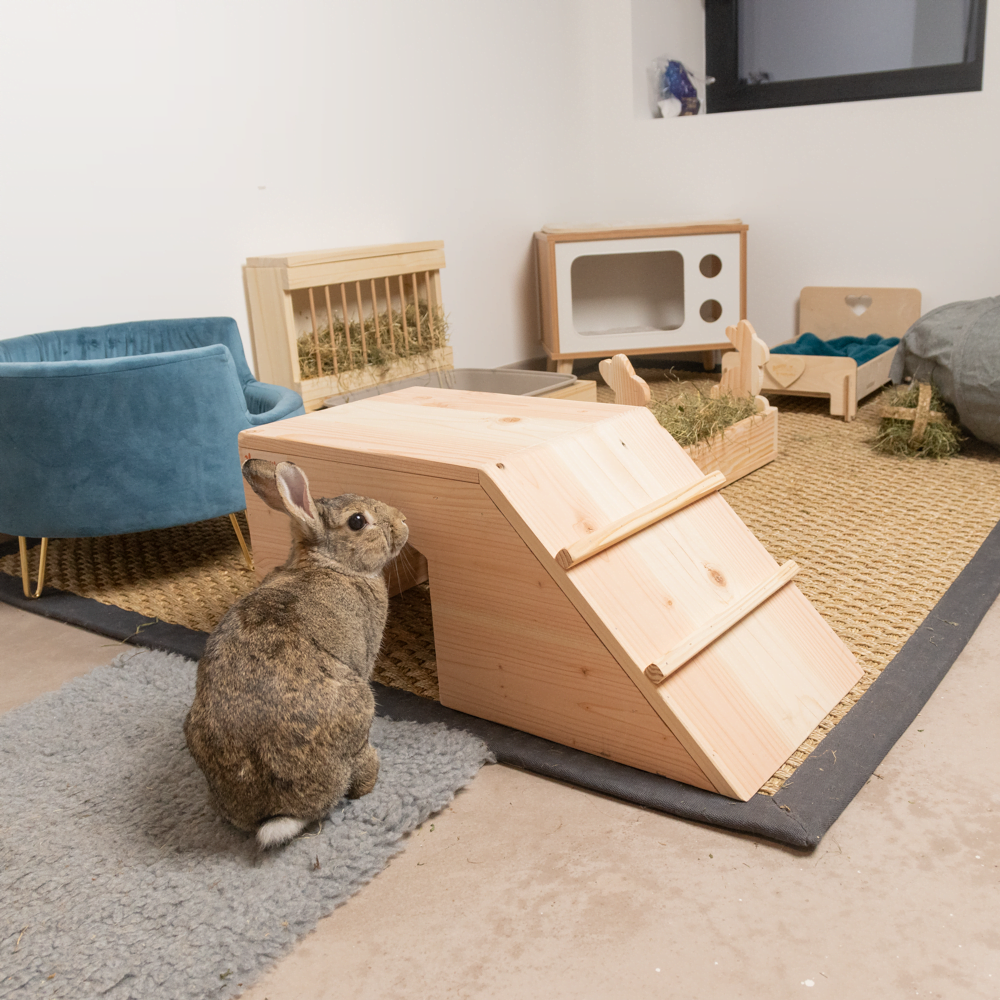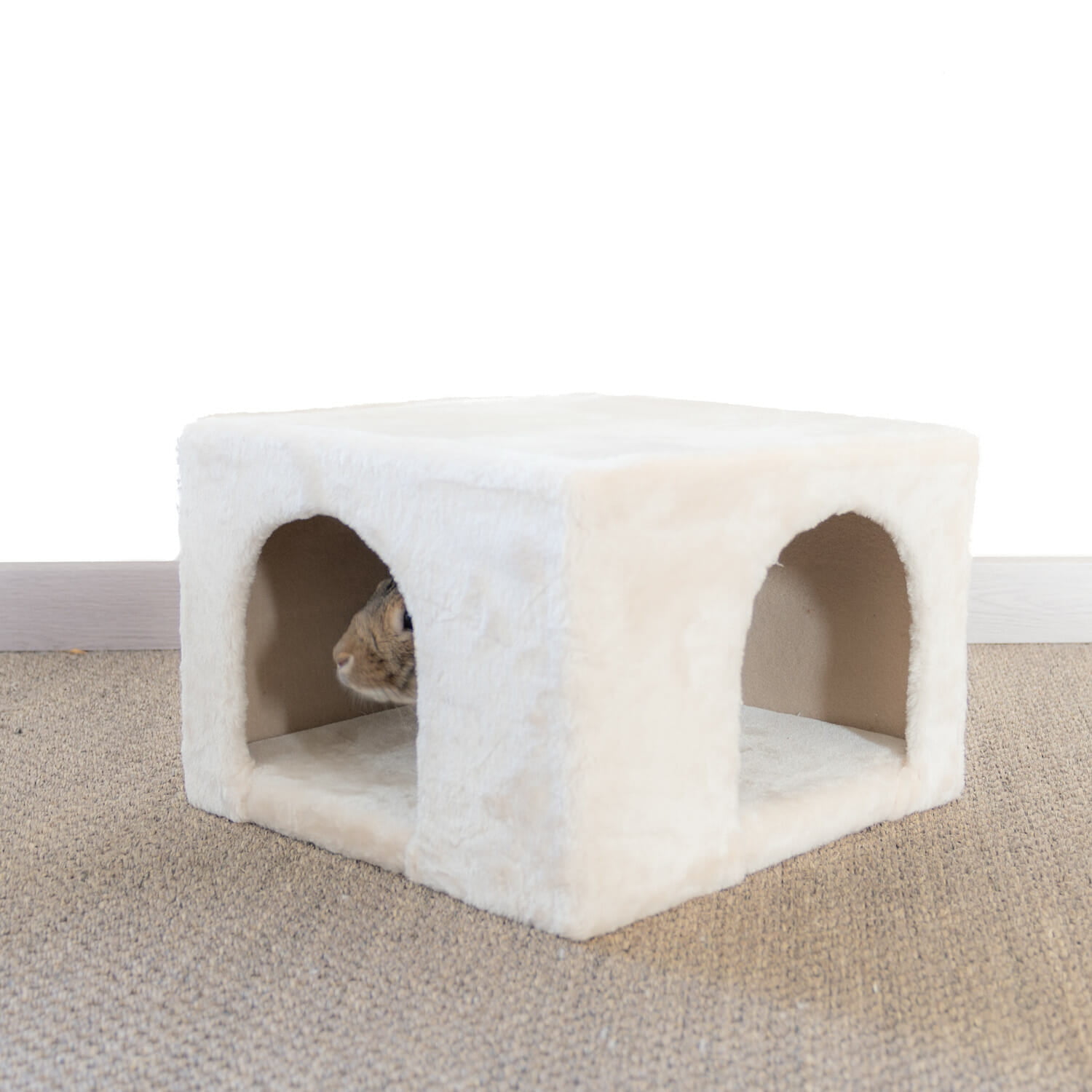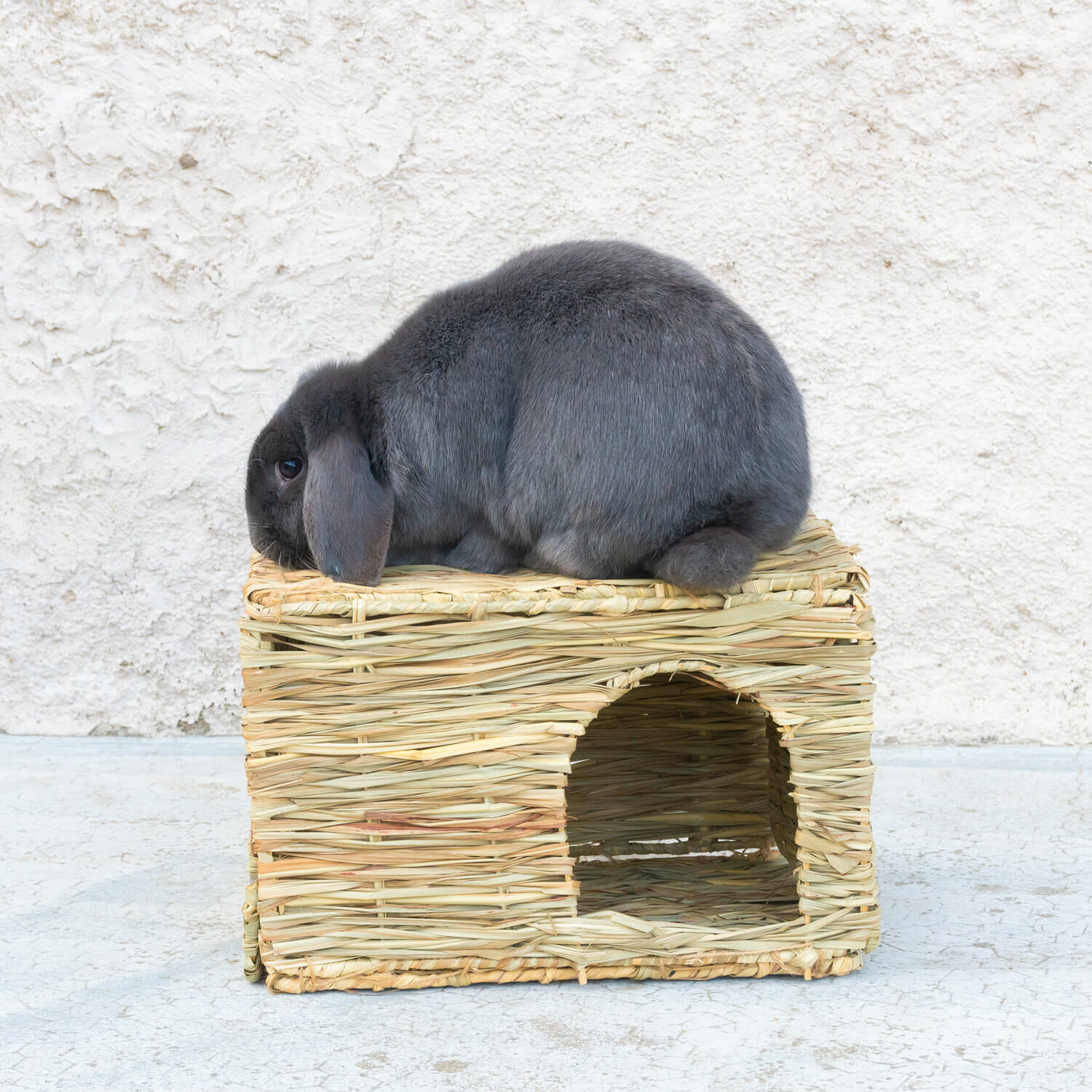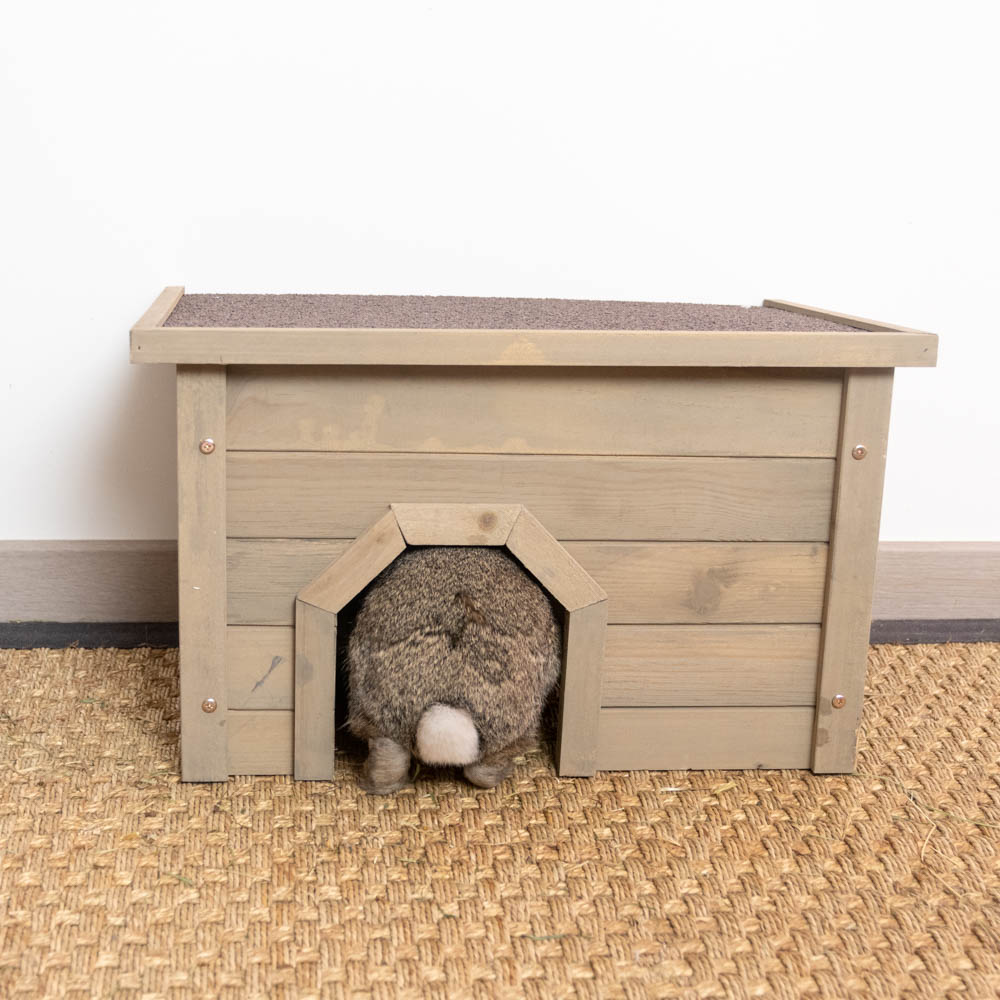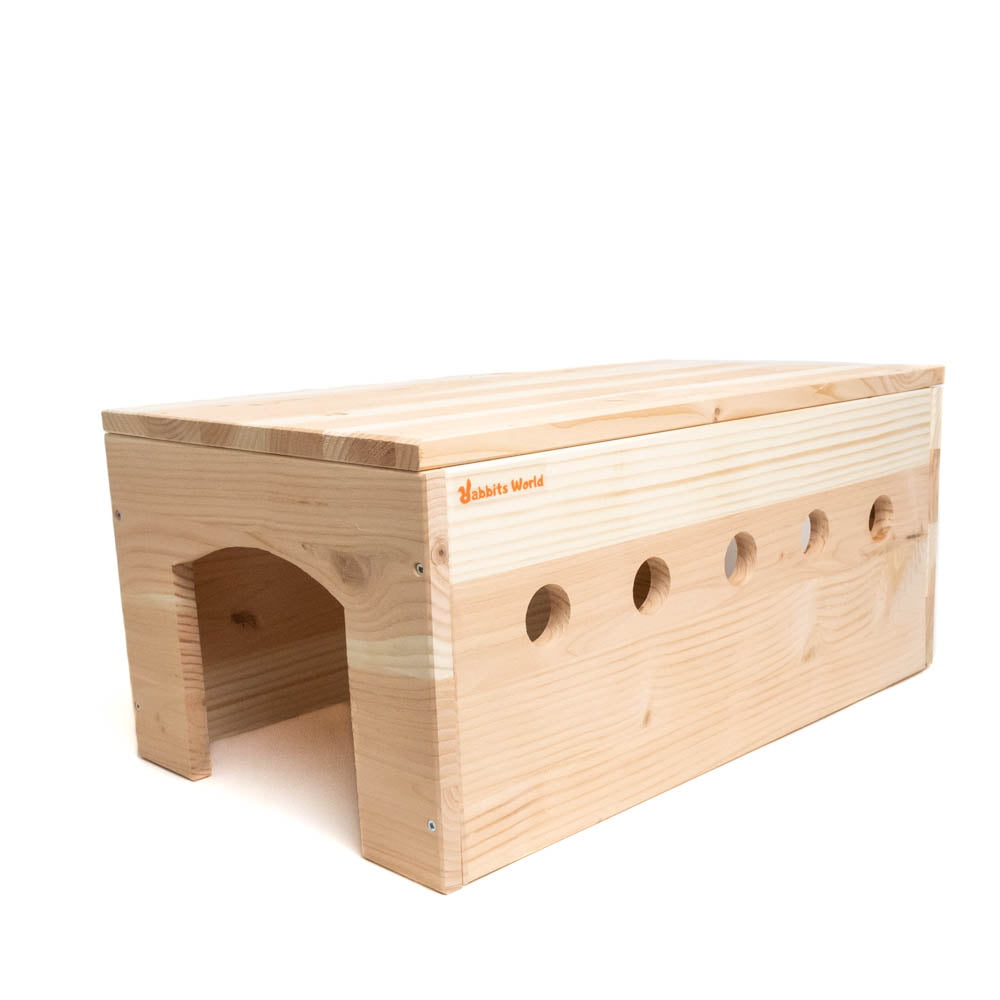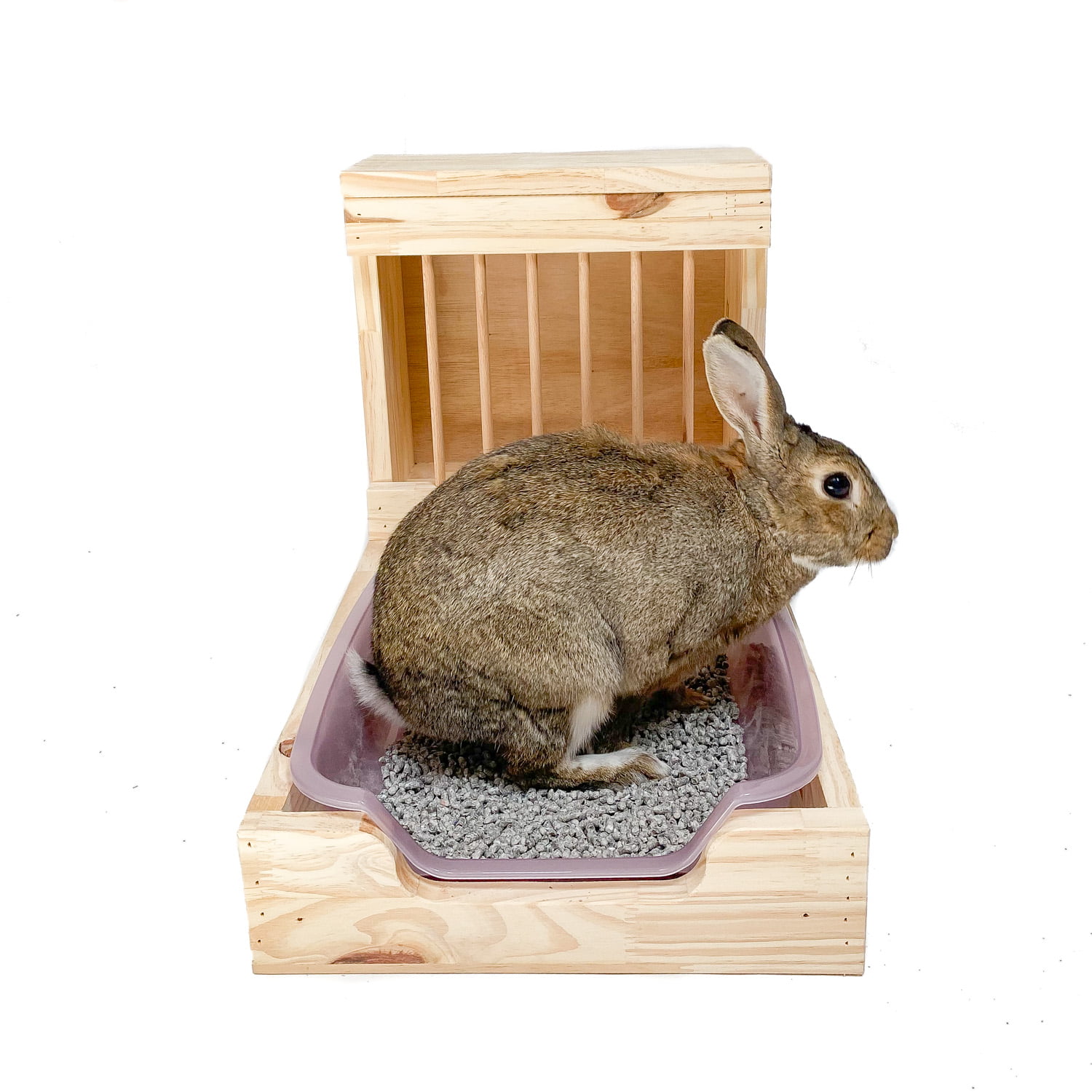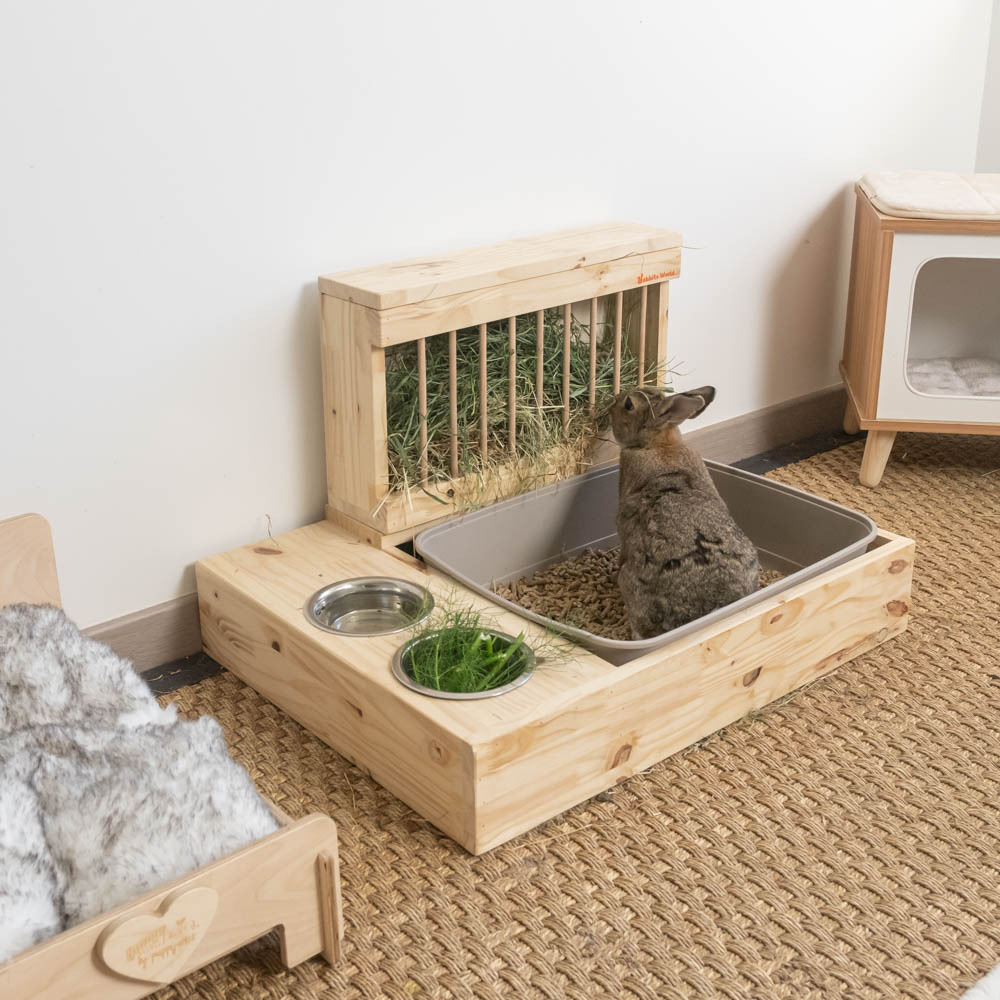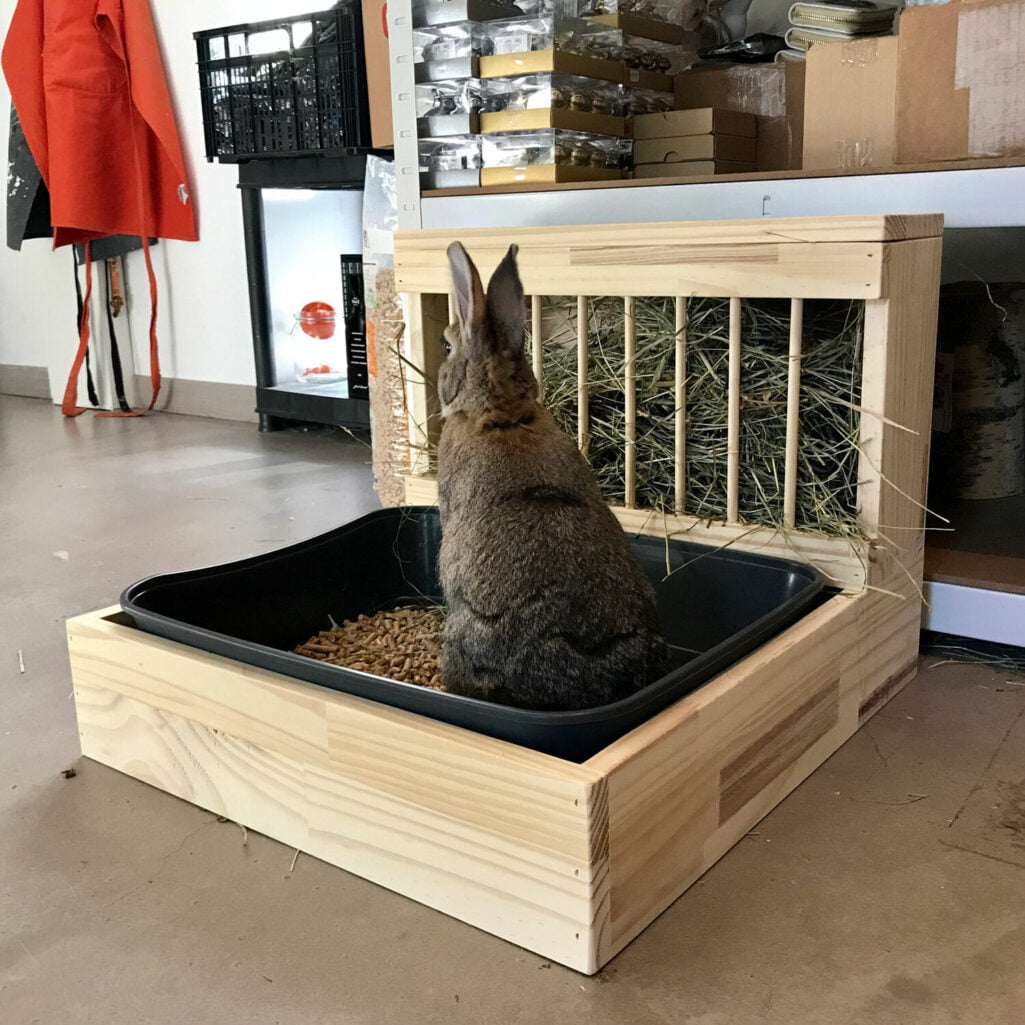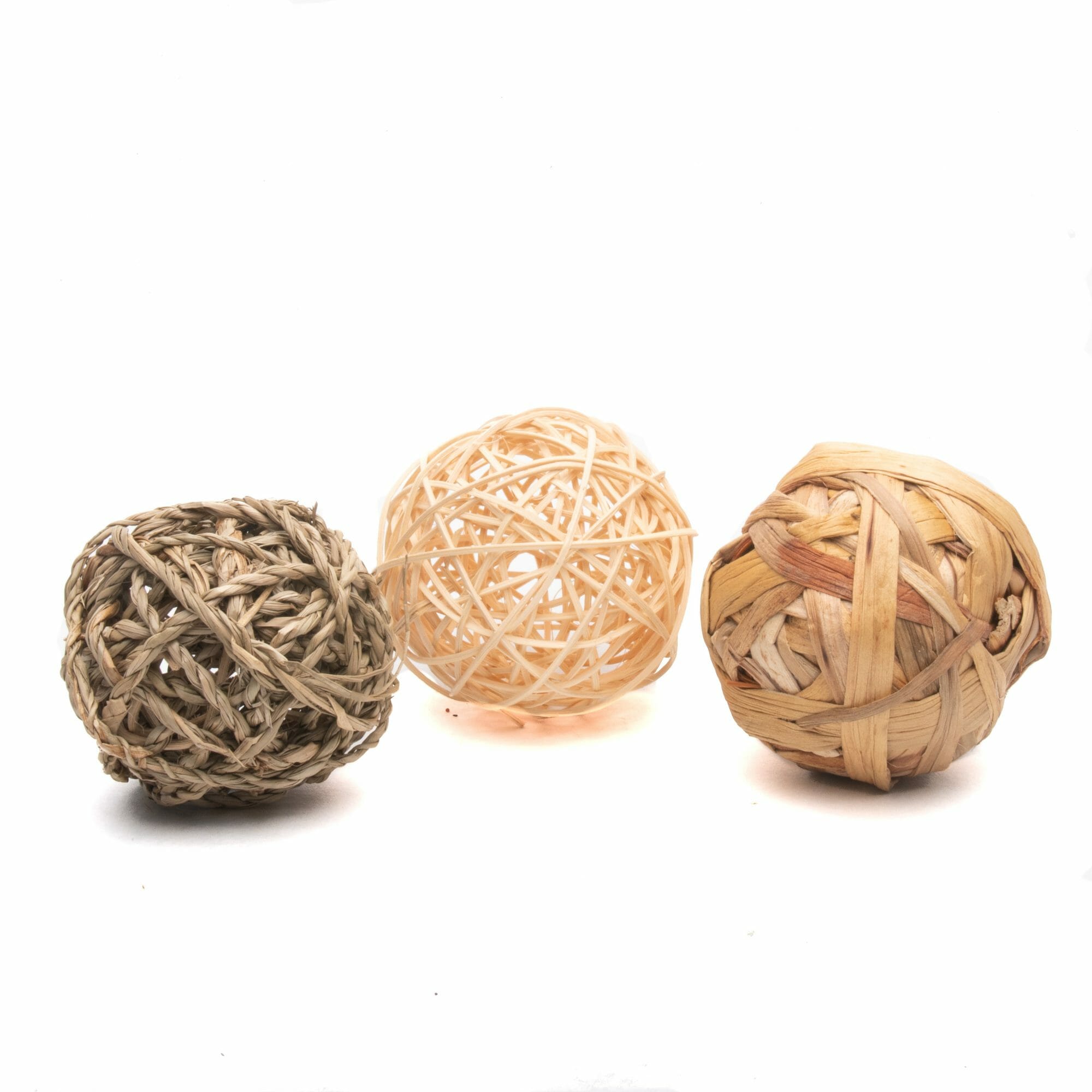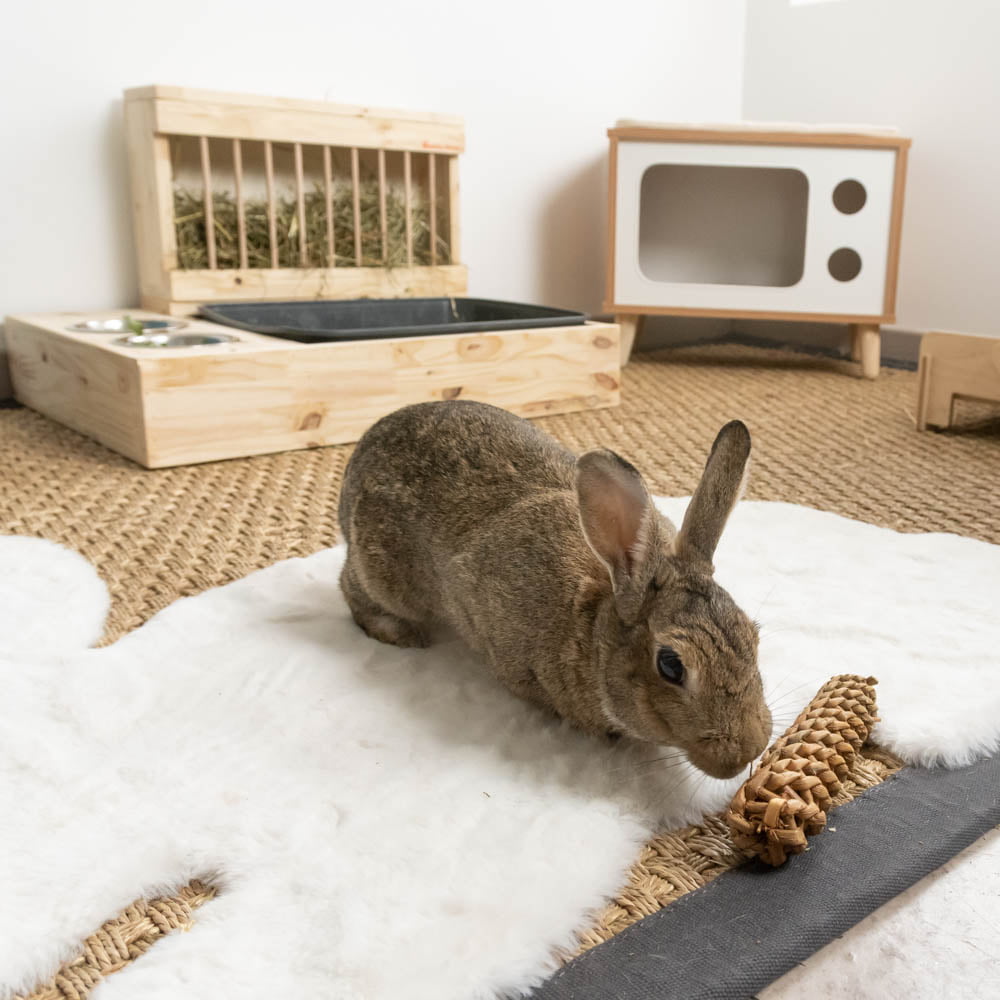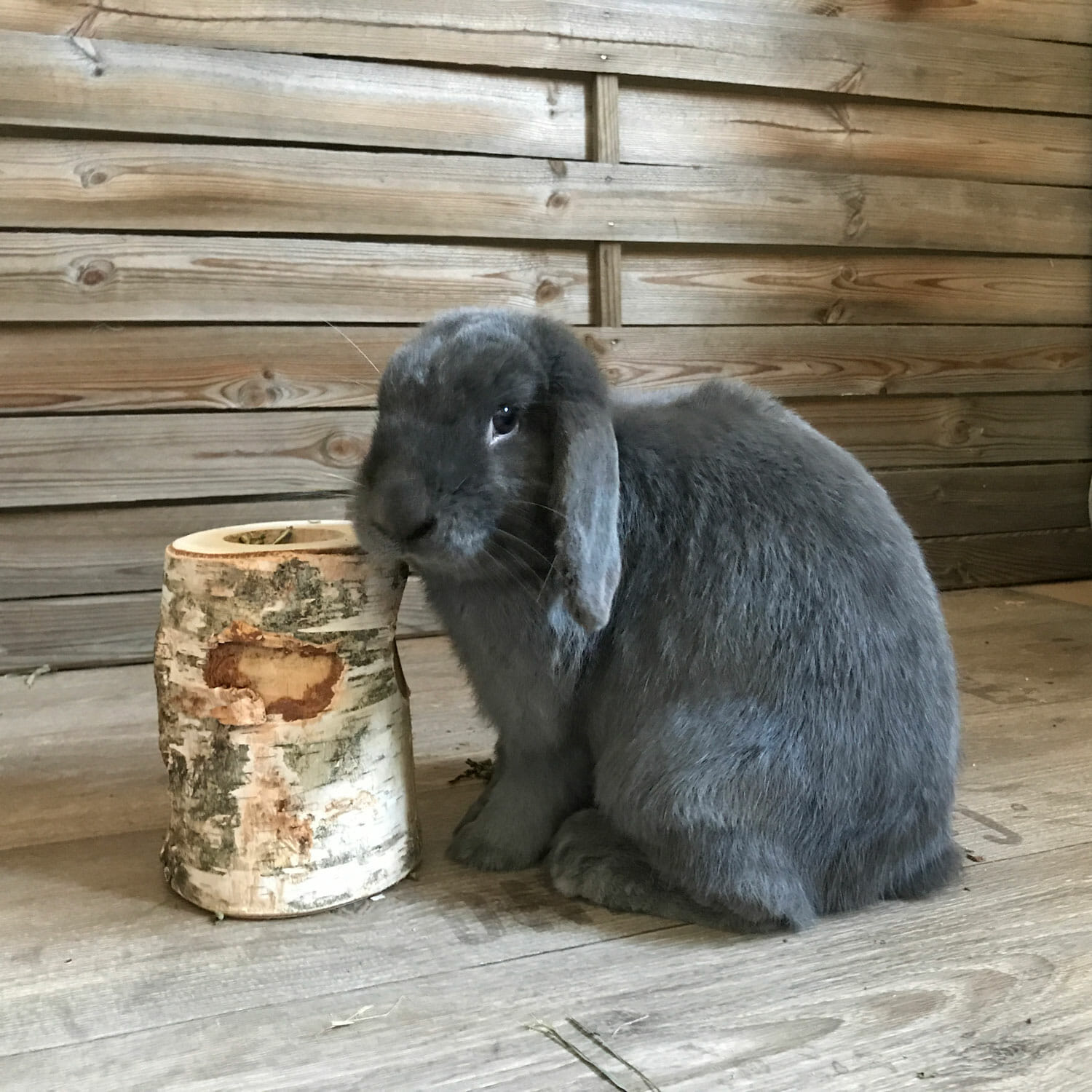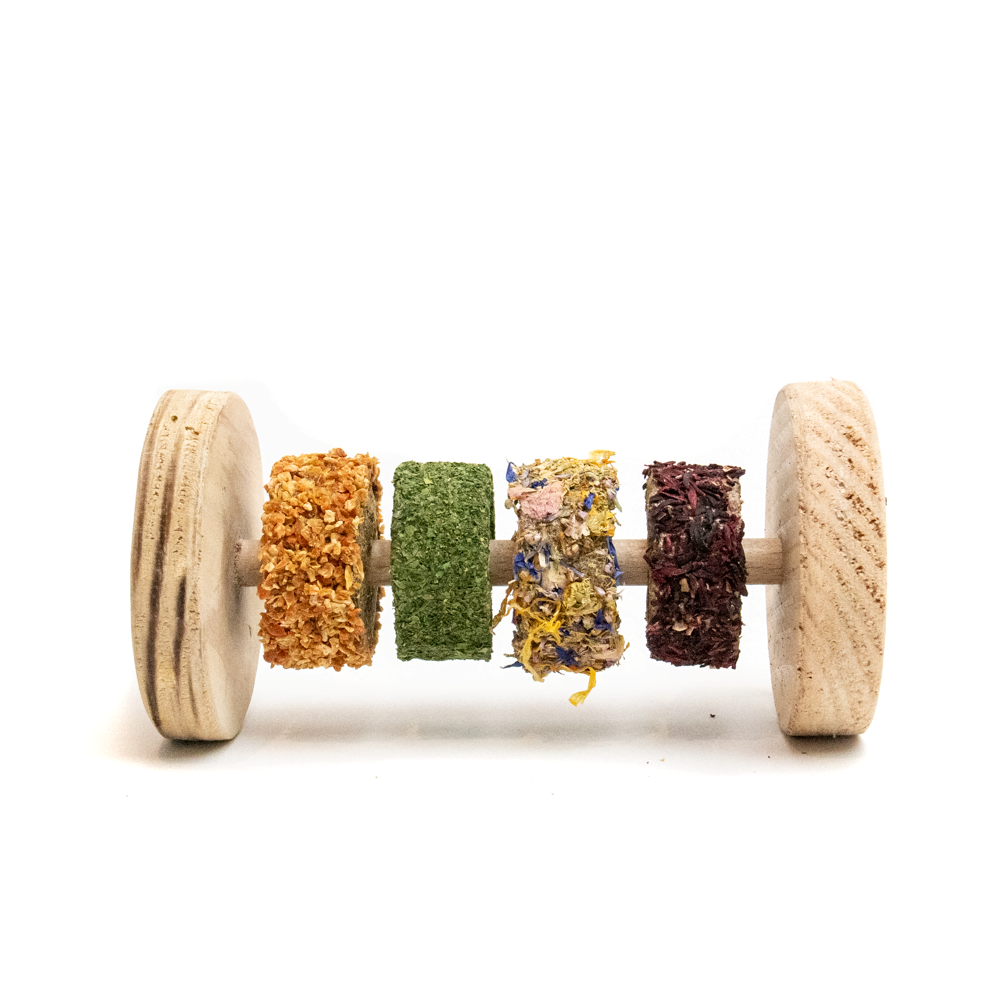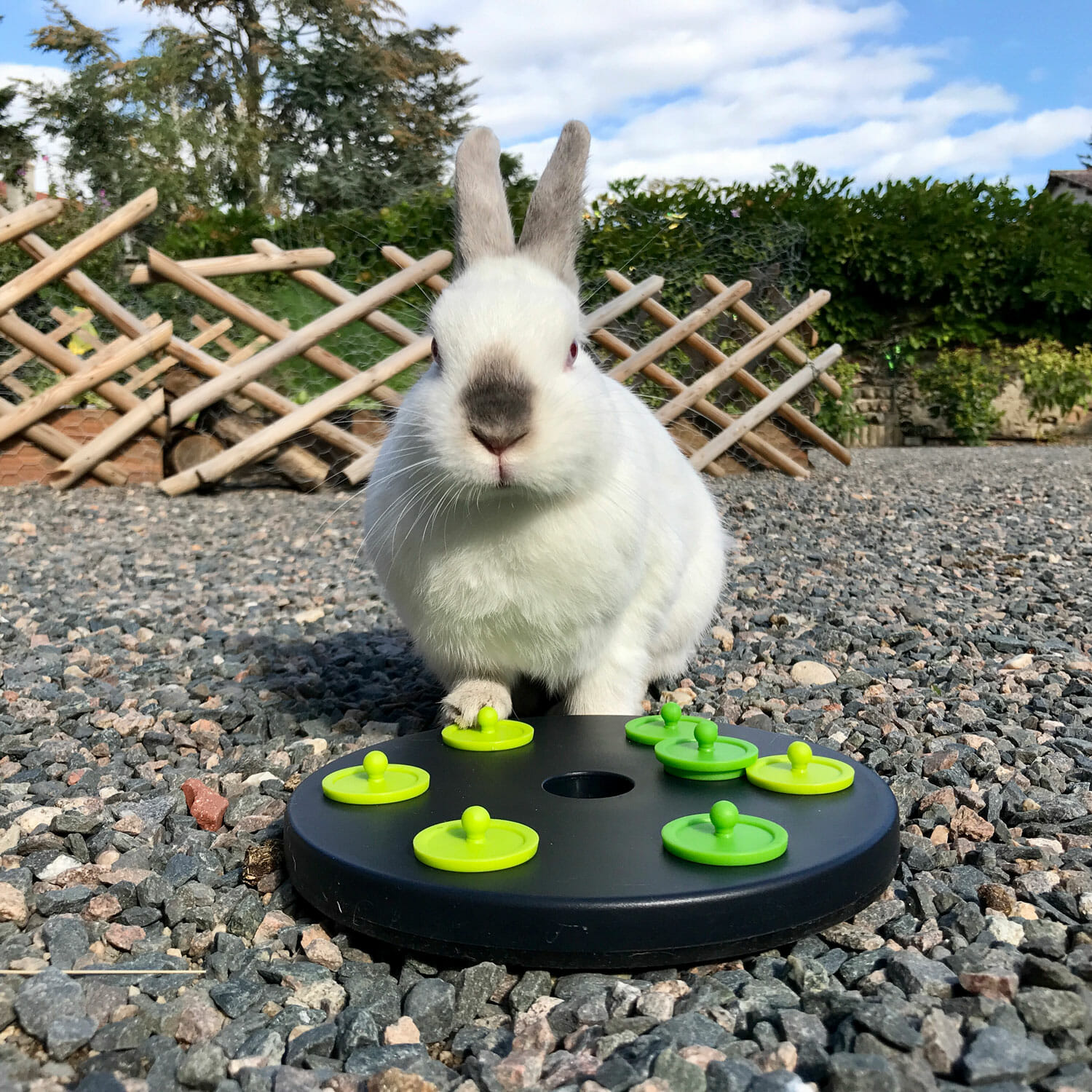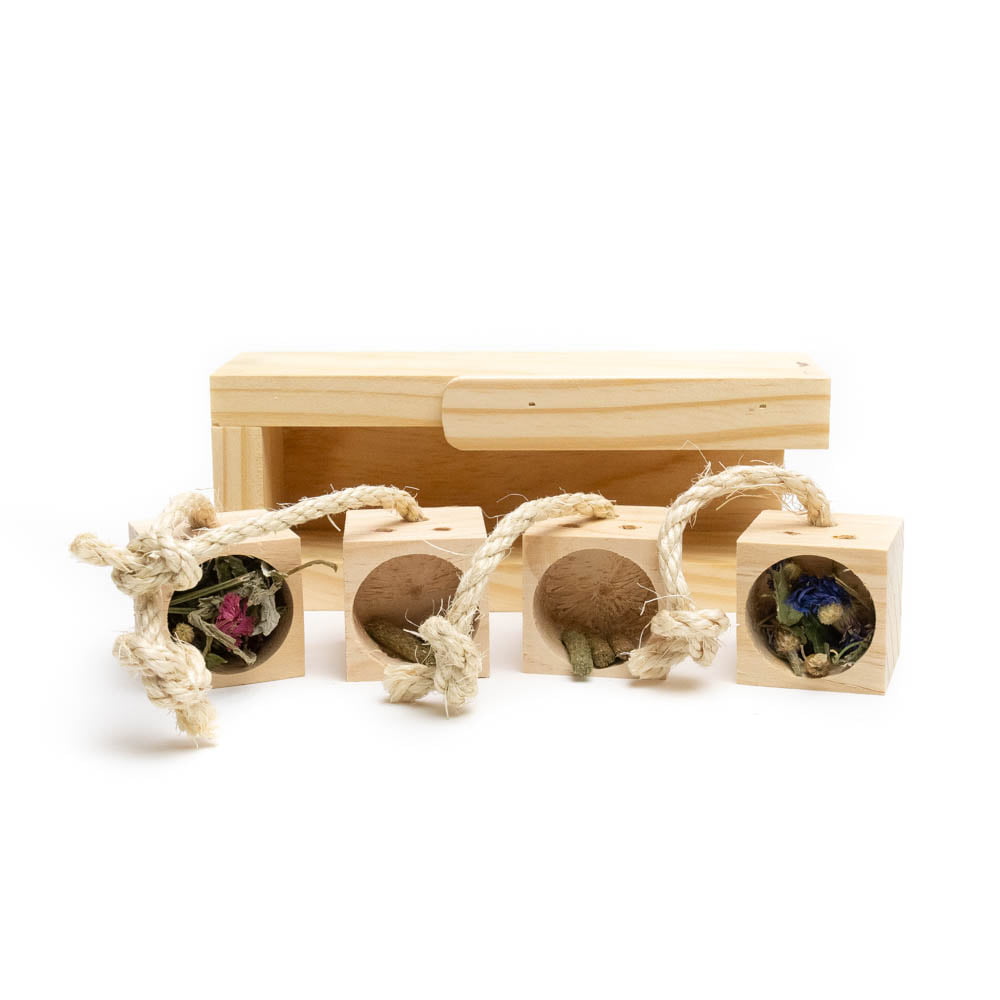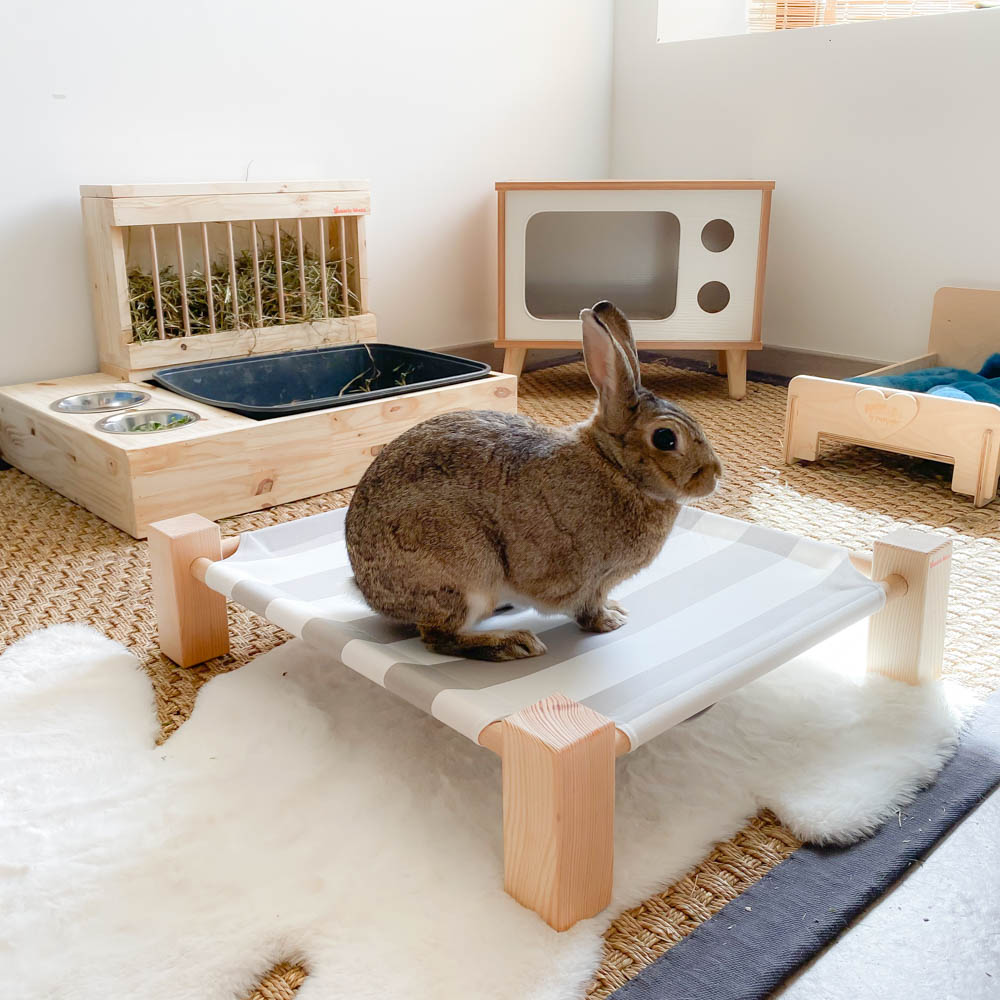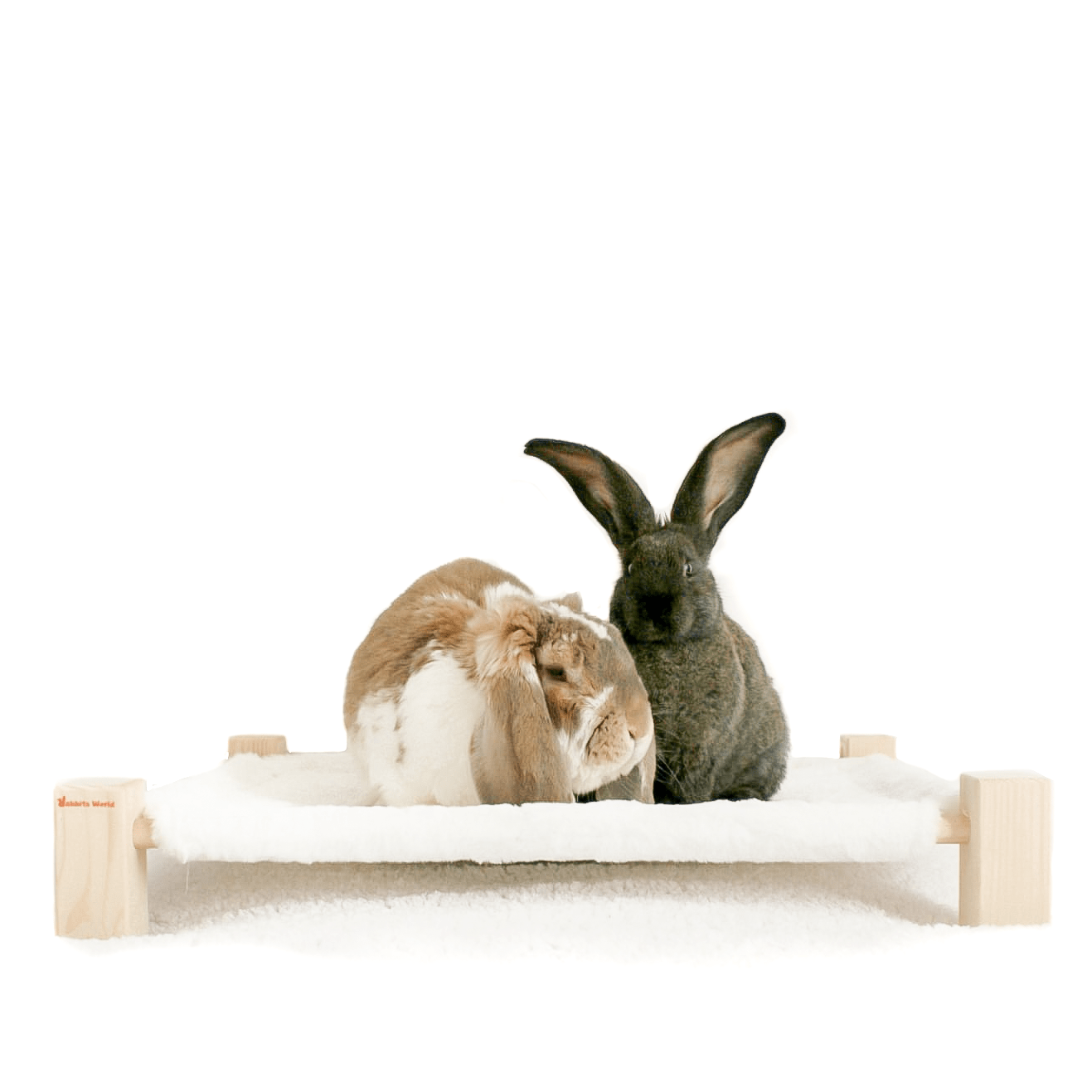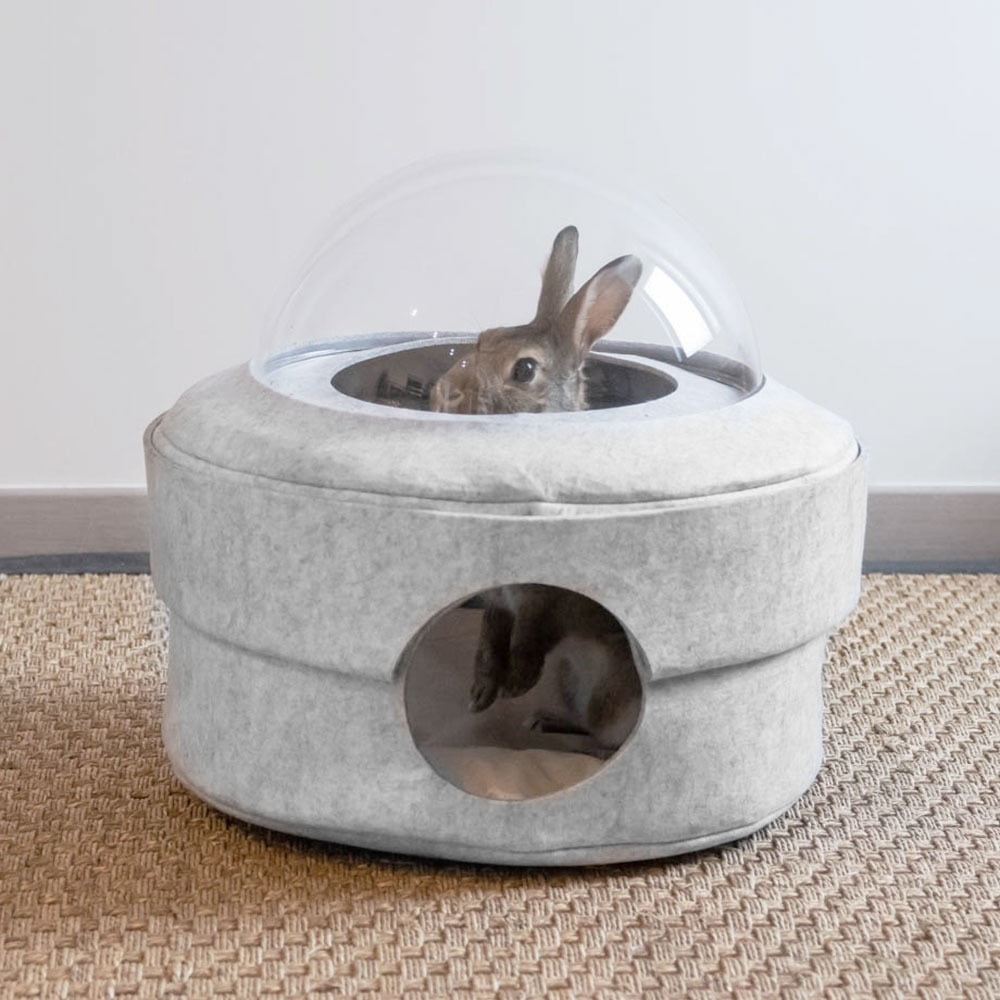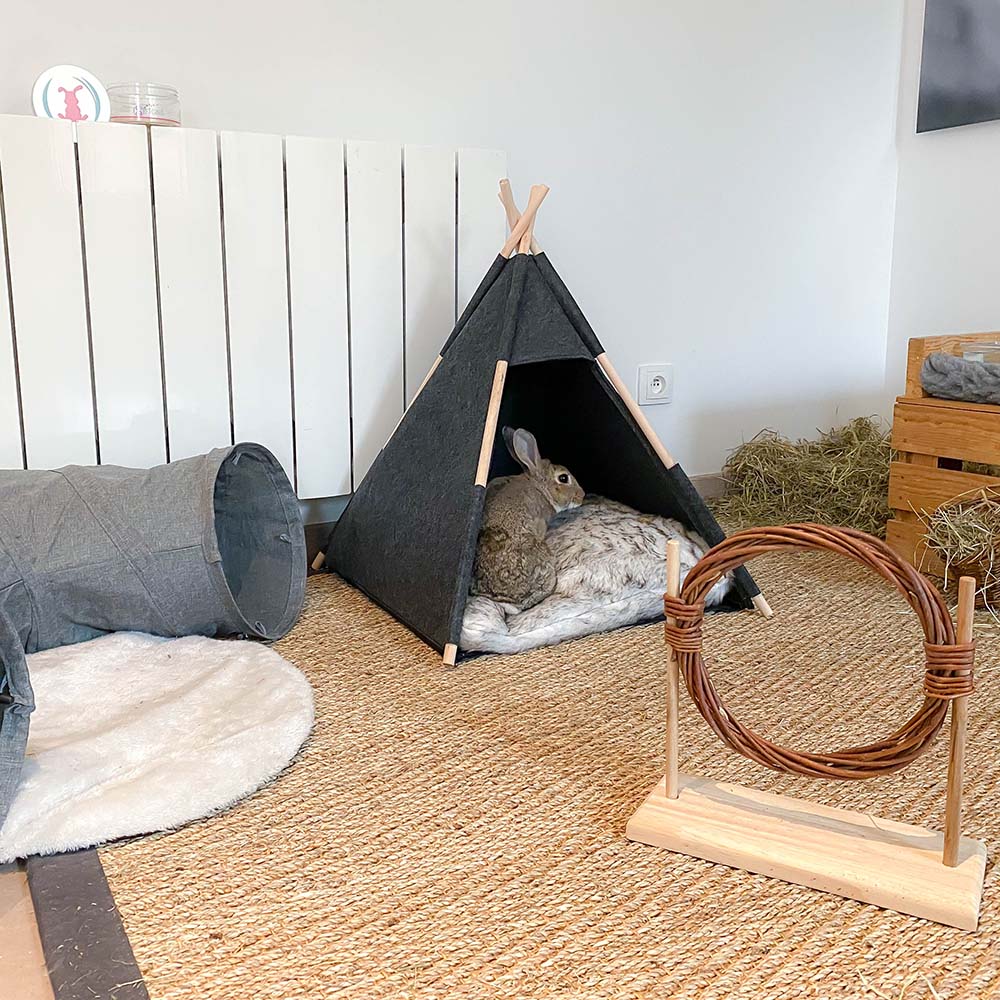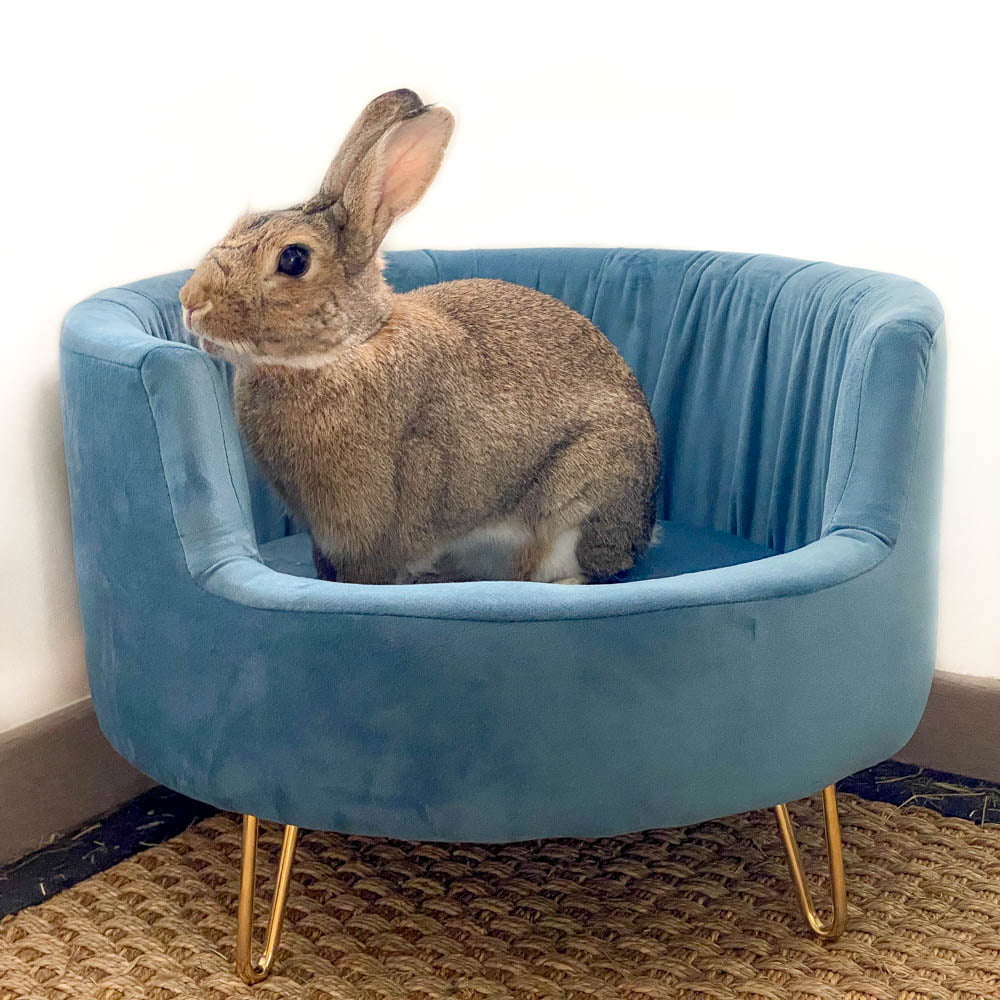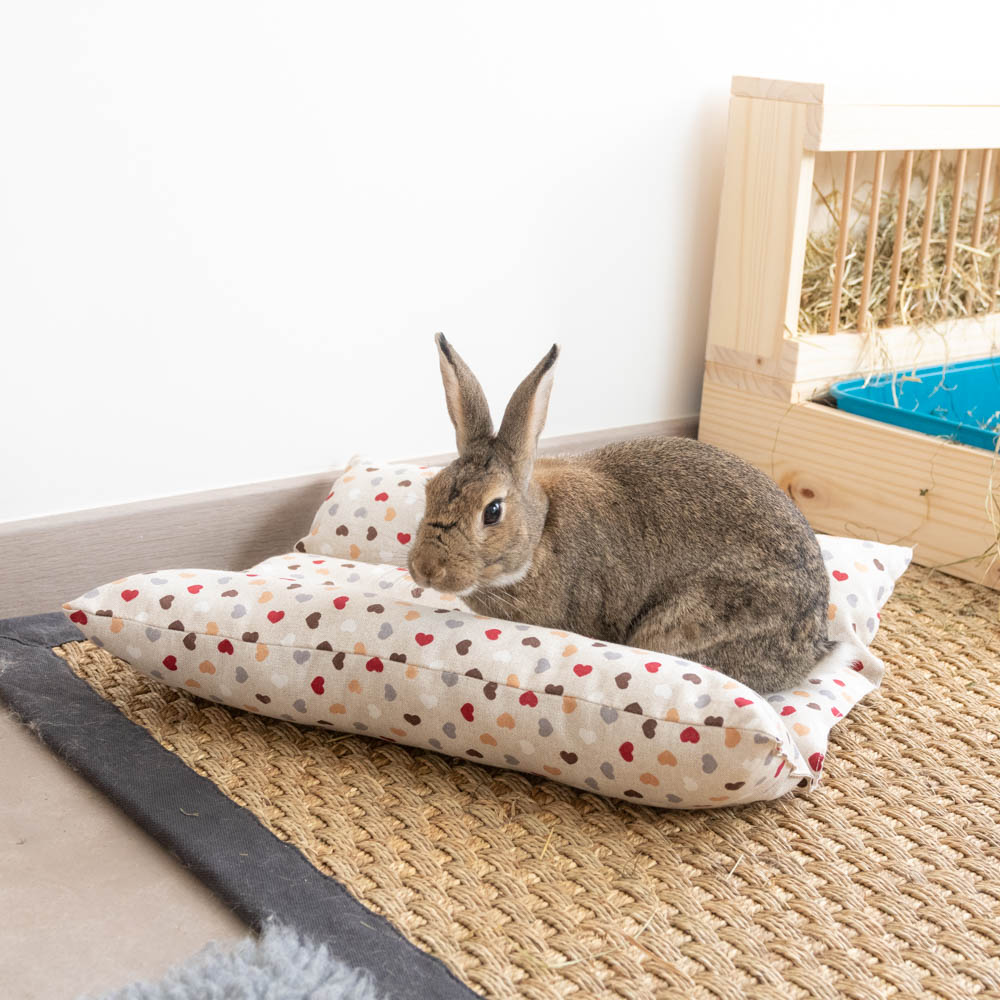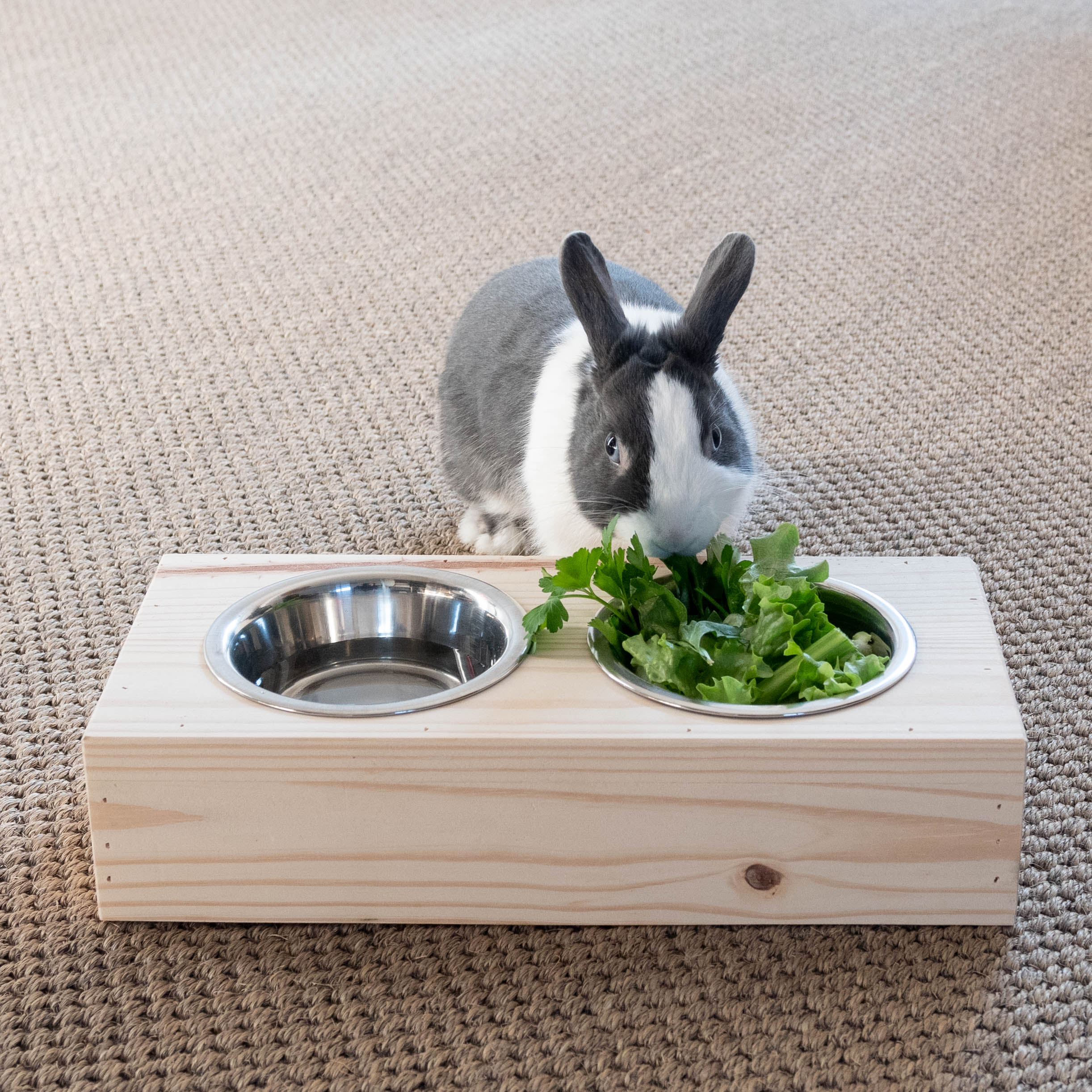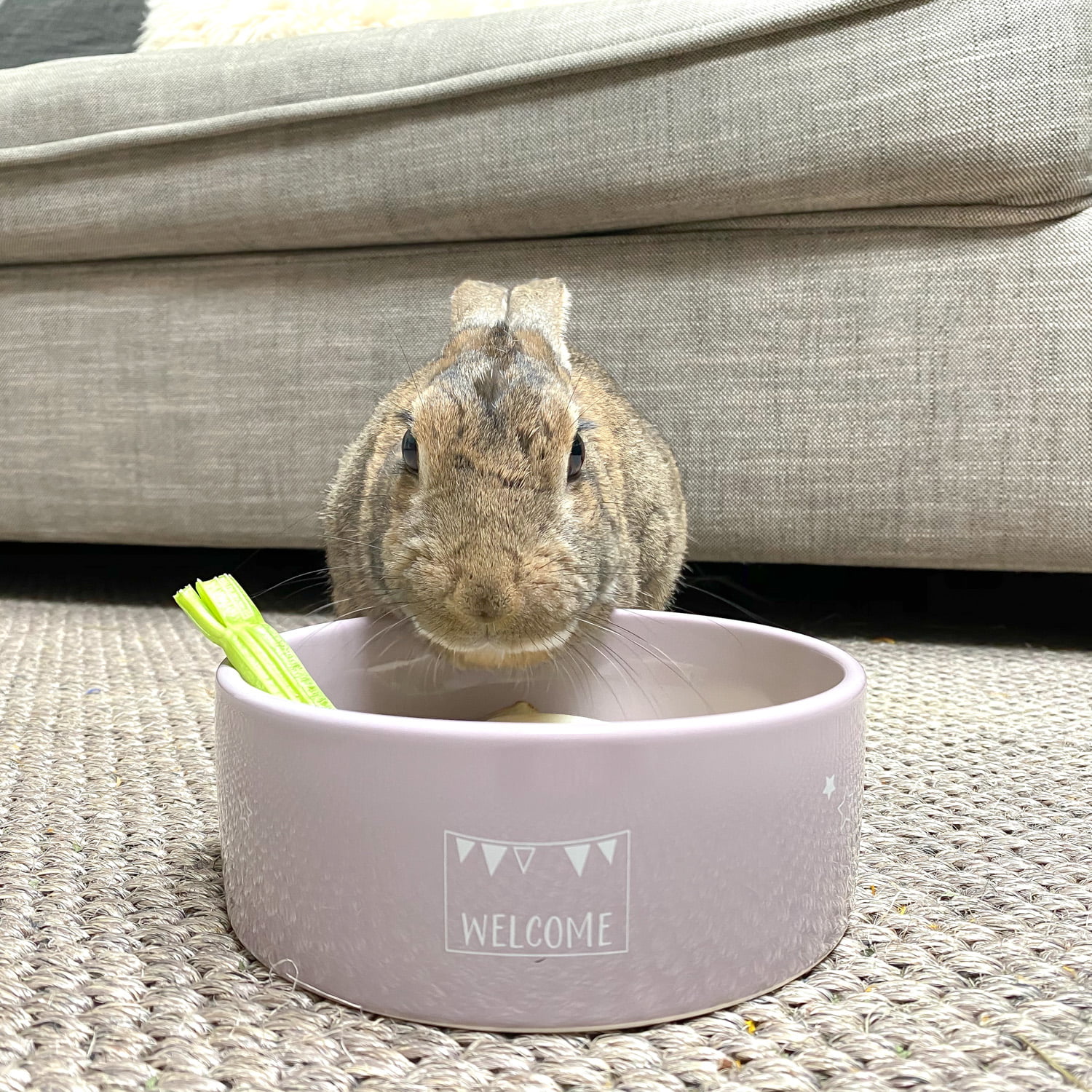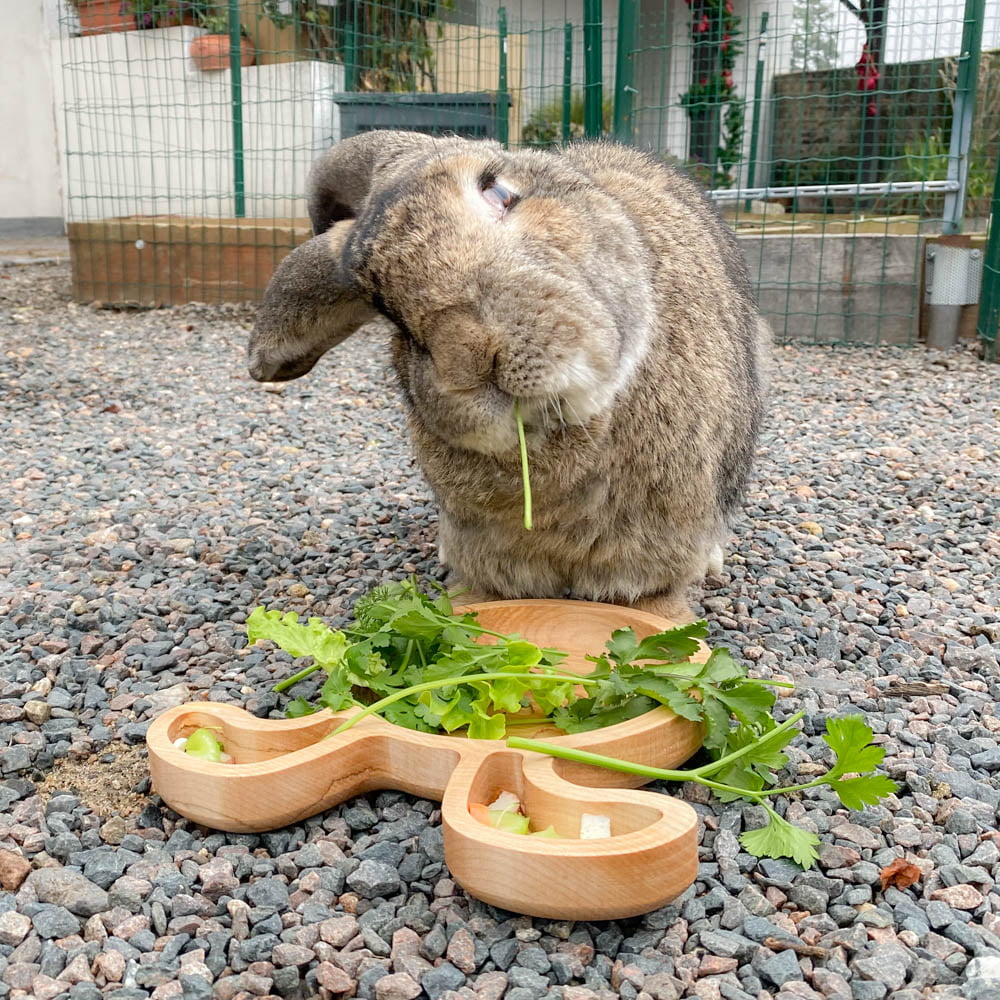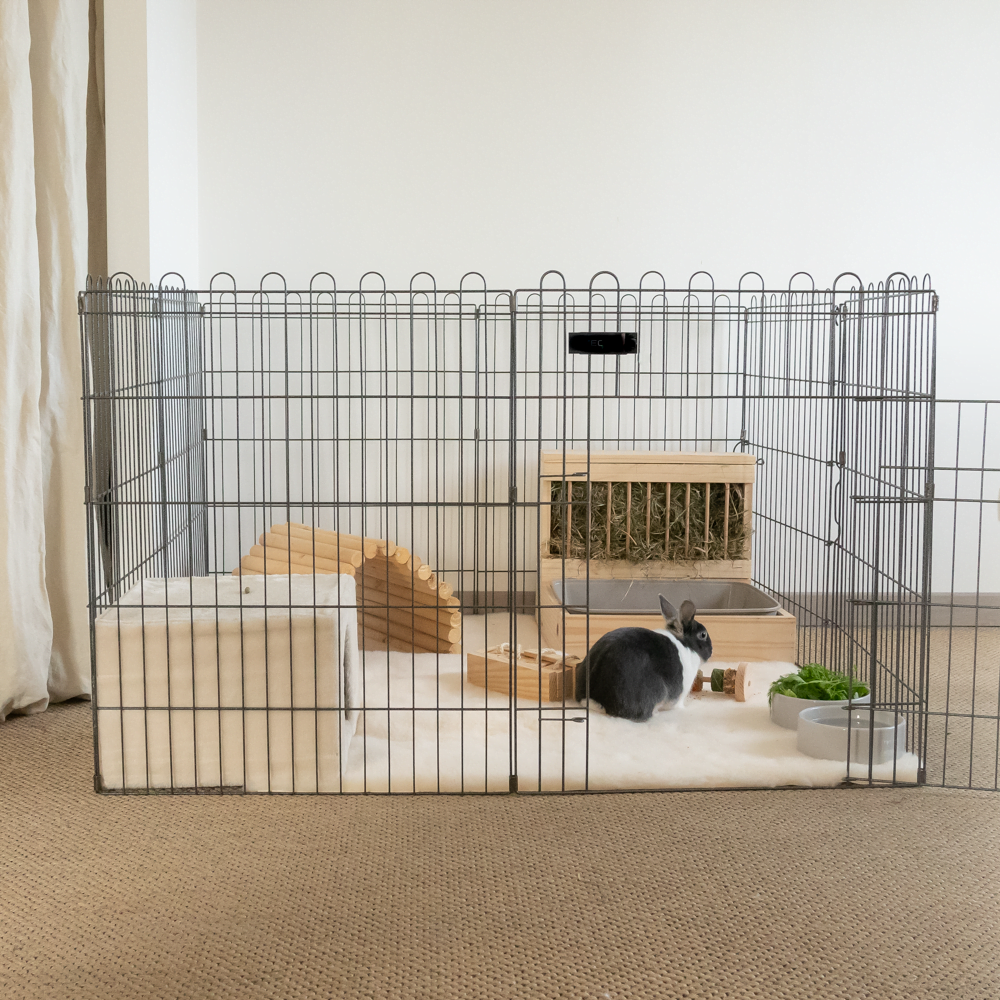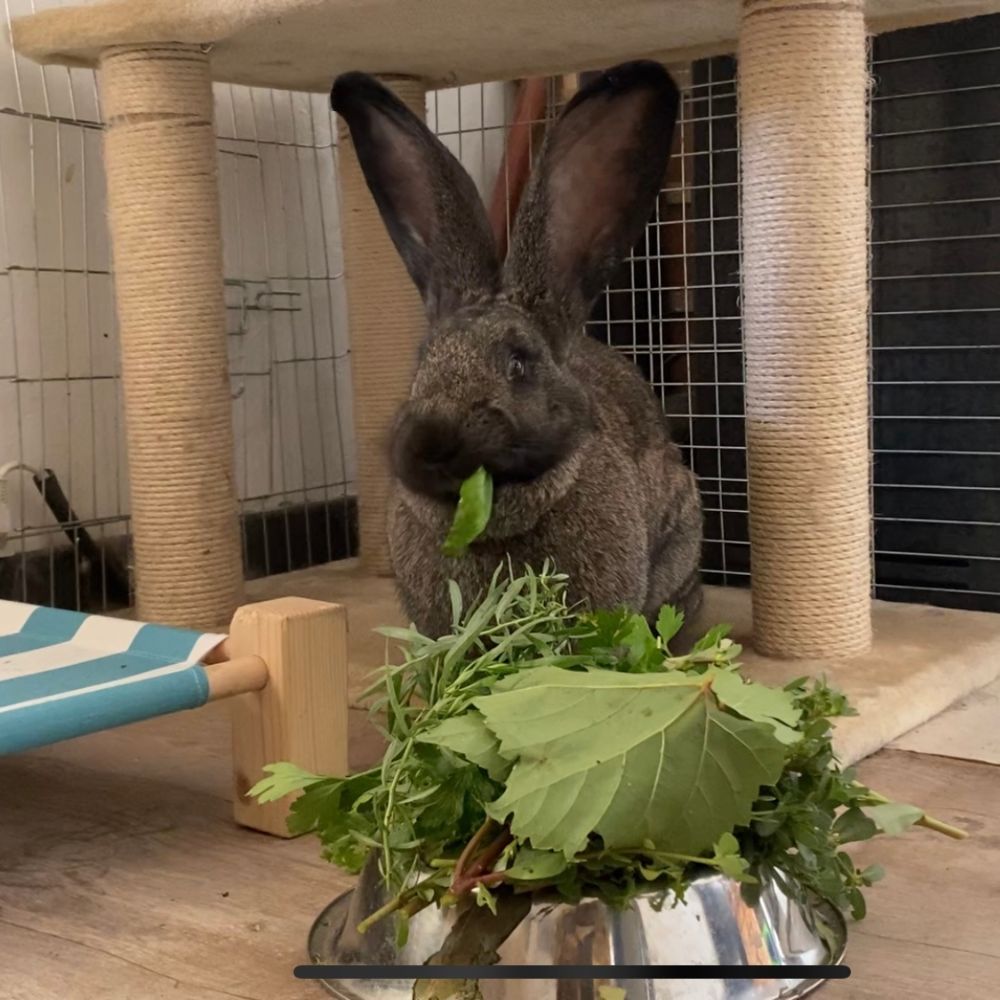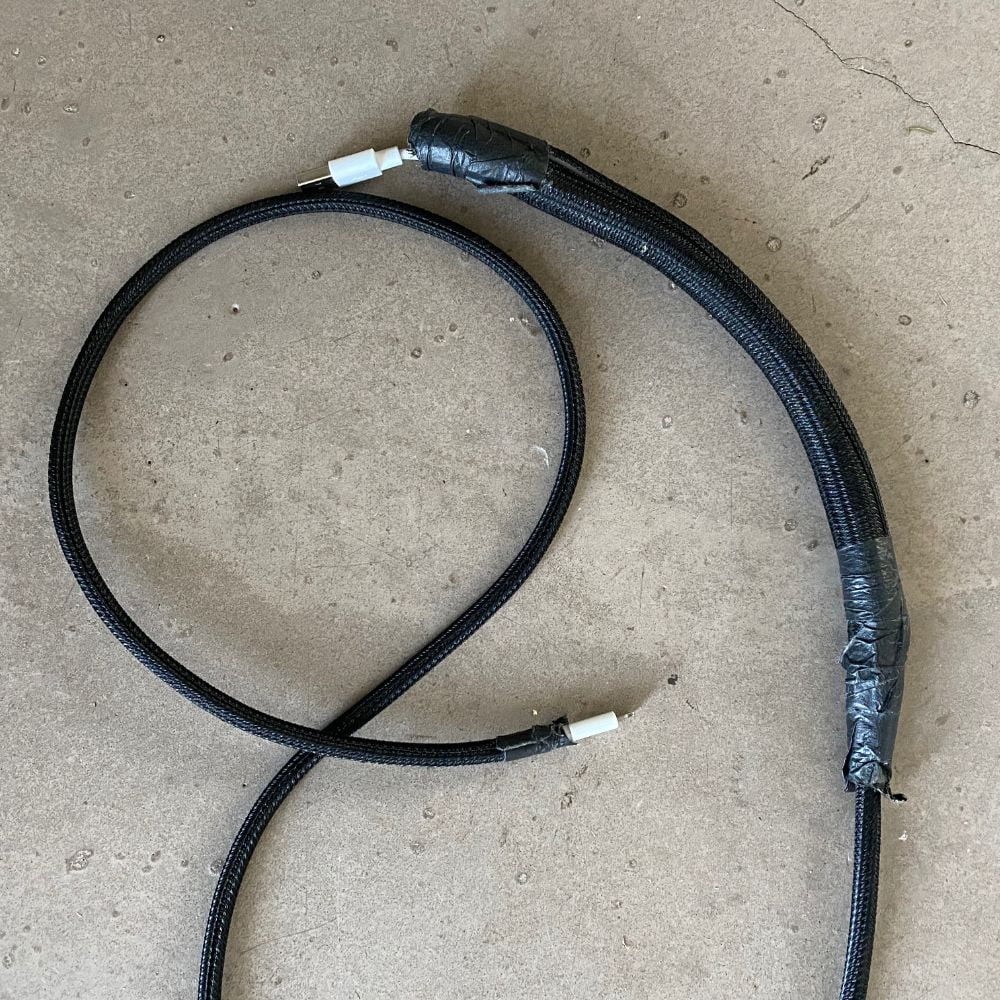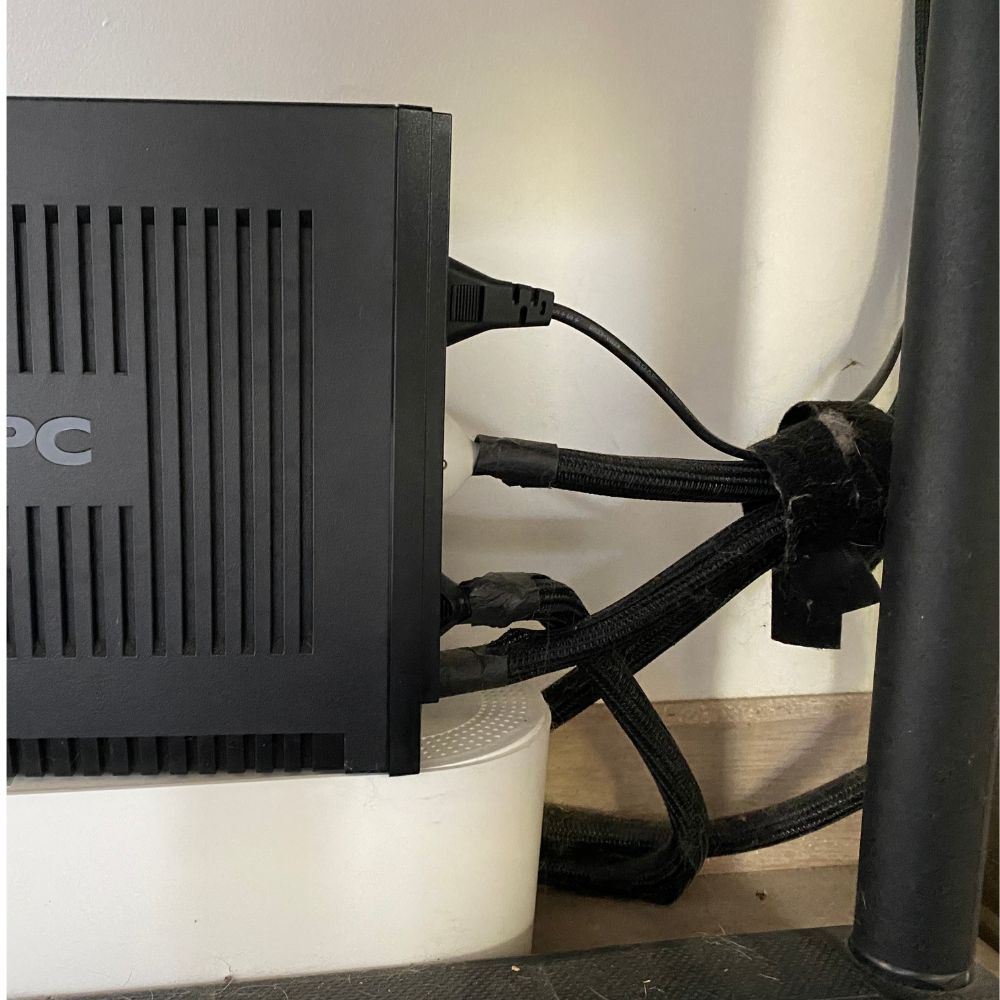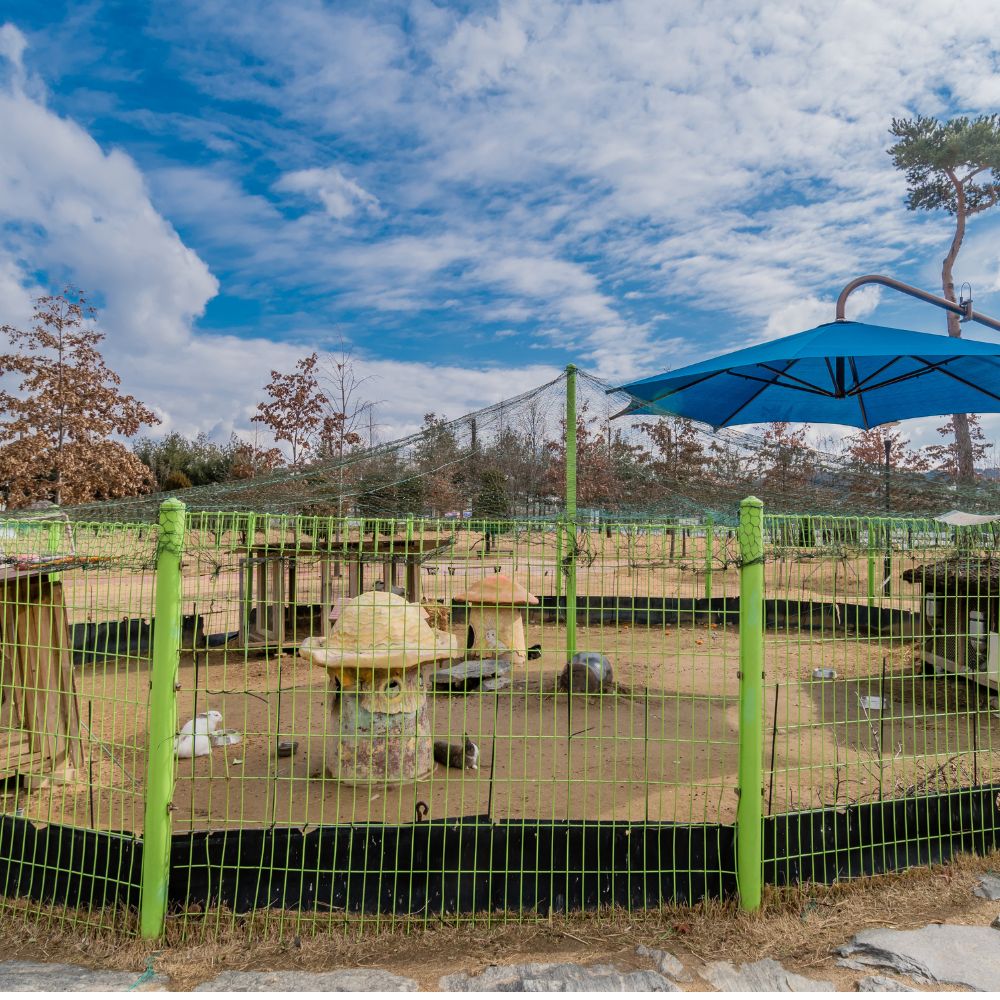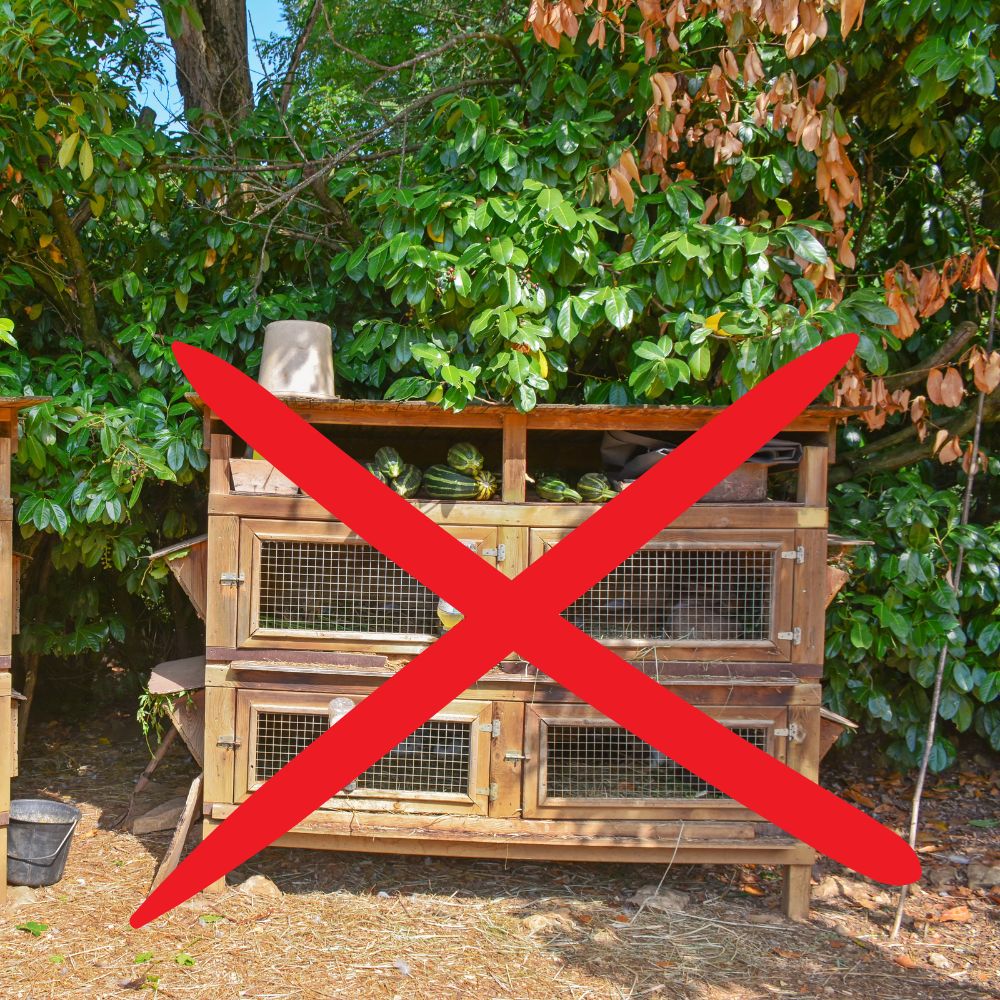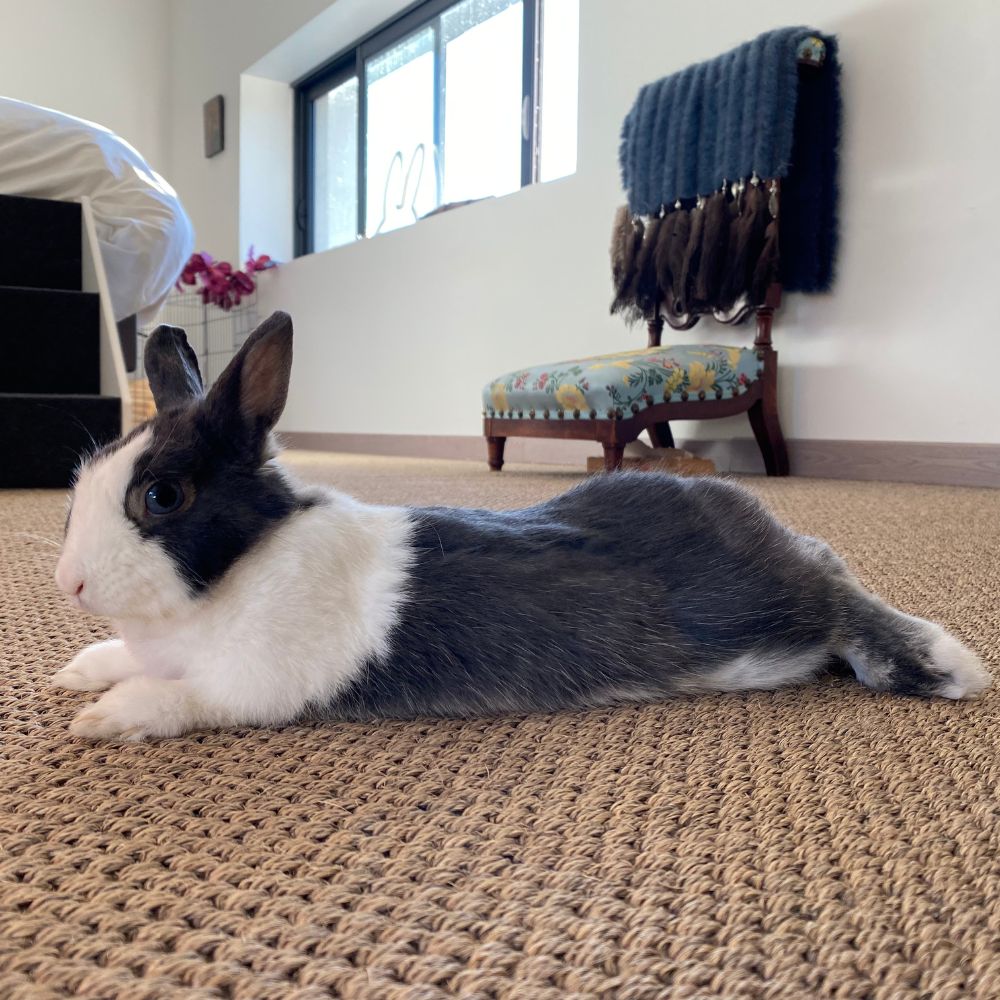Savoirs
Rabbit habitat : All you need to know
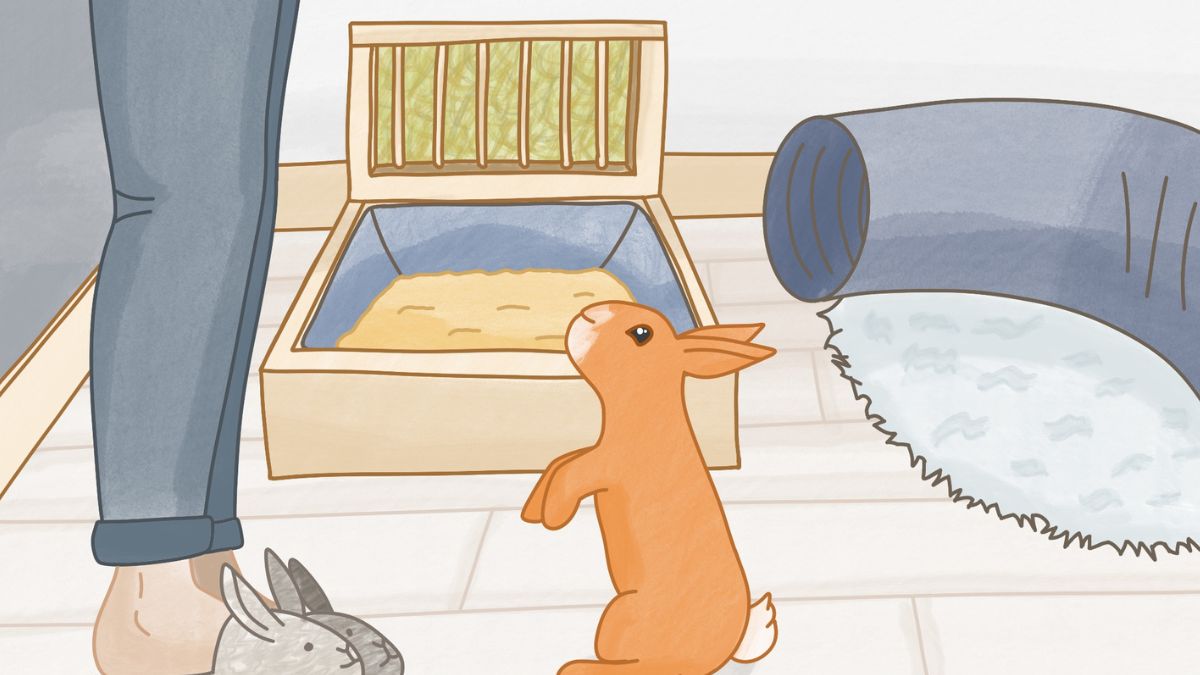
All you need to know about pet rabbit habitats
Sharing your life with one (or more) adorable rabbits, are you wondering about their ideal habitat, to give them the best possible life ? You’re right: a suitable habitat is essential to the happiness, health and well-being of your little companion. And between cages, hutches, pens, semi-liberty and total freedom, you don’t know where to turn ? In this article, we’ll take a look at your pet’s needs ! Environment, furniture, hobbies and little extras, your rabbit’s habitat will hold no secrets for you. ⤵
Rabbit habitat in the wild: the rabbit warren
Small beast, big territory !
In the wild, a wild rabbit has a territory ranging from 0.4 to 4 ha (i.e. from 4,000 to 40,000 m²). The size of this territory varies according to the abundance of food and the number of rabbits living there.
Because rabbits are social animals, they live in communities. And the larger the community, the larger the territory. Thus, for the largest groups (numbering around twenty individuals), the size of the territory can be as much as 9-10 ha !
Burrows, single or shared
On this territory, rabbits dig burrows.
Each rabbit or pair has its own burrow, which it may or may not connect to another to create a network of galleries. This behavior not only encourages social interaction (“hey, neighbor !”), but also increases the chances of survival in the event of predator attack (you enter on one side, but leave on another).
Contrary to what you might think, these burrows are not dug haphazardly: as is often the case with rabbits, their layout responds to a hierarchical imperative. Thus, the dominant pair will occupy the center of the territory, while the dominated will be relegated to the periphery, more easily accessible to predators, and generally less rich in food.
Hedges and bushes: hiding places are essential
In their natural habitat, they occupy a variety of spaces: moors, clearings, woods… But they all have one thing in common: more or less dense vegetation providing a makeshift hiding place in the event of an unexpected attack.
In fact, as we saw above, rabbits have a vast territory; they don’t stay close to their burrows all day long, but explore, eat and mark the boundaries regularly. This doesn’t always leave them time to return to their burrows if one of their fellow rabbits warns them of danger by tapping their paws (to find out more about their language, go to our dedicated article). There must be enough hiding places (hedges, bushes, etc.) to ensure everyone’s safety.
Rabbit habitat: How about a parallel with humans ?
To help you identify their relationship with their territory, allow me to draw a parallel with our own living spaces.
The burrow is like our apartment (or house). We feel safe there, raise our children there, defend it against intruders, keep it as clean as possible and sleep there.
The network of galleries linking several burrows is similar to a building: you meet your neighbors, you’re passing through on your way home, but you don’t stay too long. Essentially, it meets a need for circulation.
Their territory would be our neighborhood. We know the faces we meet there, we go there to get our food, we know the shortcuts, the roundabouts, the places to take refuge in case of trouble. We sometimes stroll here, soak up the sun, stretch our legs or go for a jog. And the more amenities a neighborhood has, the less we need it to be.
Recreating these conditions at home: life in the wild
Out with the cage
After all you’ve just read, I’m sure it’s obvious to you by now: no matter how big or small, a cage is not a suitable habitat for rabbits. First of all, because it’s obviously too small (yes, even those presented as “XXL”). As we saw above, rabbits live on a territory of several hectares centered on their burrow. In a pinch, it would be possible to assimilate the cage with its burrow, but then you’d have to offer it a vast territory, accessible at all times, and which would meet its most primitive needs: scratching, digging, jumping, running, playing… In other words : life in the wild 😏 #CQFD
However, using the cage as a rabbit hole is not suitable either. If we take the characteristics of a rabbit hole, we have : a soft, loose floor, almost 360° protection, one entrance and several exits… Do we have all this in a cage ? No.
The bottom of the cage has a hard floor, which is very irritating for his paws. Your little darling is likely to develop painful pododermatitis on this type of surface, which will restrict his movements and make him suffer!
The cage offers no protection against intruders (well, not according to your rabbit, who is waiting to be hidden from predators). Your pet can’t feel safe in a cage, trapped in a space it can’t control, and from which it can see all kinds of threats staring at it, talking to it, or even trying to catch it. The cage is a source of stress for them!
Finally, the cage, open 24 hours a day and used as a home, is not ideal either: forcing your pet to jump to get in and out, sometimes even forcing him to use a ramp with bars where he can injure himself, it takes up unnecessary space in your home and threatens the health of your little beast. So there’s only one sensible thing to do : avoid (or stop) using them.
Here’s a good idea : do you own a rabbit cage (1 m or more in length) that you’d like to get rid of ? Do a good deed by offering it to a hedgehog care center ! They use these cages for hedgehogs in convalescence or for litters of choupissons requiring constant attention. Unfortunately, in the event of a serious or highly contagious infection, they have to get rid of some of the cages, so they need them regularly ! So don’t hesitate to contact them to offer yours 🙂
Essential equipment
Now that a cage is no longer an option, what habitat should you offer your rabbit ? What equipment and accessories do you need to keep him happy and meet the demands of his lifestyle ?
Don’t worry, we’ll take a look at it all together 😉
1 – A soft floor for paws
It may seem strange to start with the floor, but you won’t be able to do much about it once the rest of the furniture is in place 😁
As we saw earlier, rabbits need to evolve on a relatively soft, non-slippery floor. As a result, certain parquet or tiled floors can cause him problems, forcing him to move around Holiday on ice-style, or, in the case of porous tiles and hard floors, by causing tiny wounds to his paws, repeated with each move, which will end up in pododermatitis.
So what should you do ? Do you really have to carpet your whole house to keep Lapinou happy ? Fortunately, no 😉
Let him move around on different surfaces, from one room to another, for example, and offer him a few good-sized rugs in a variety of materials, ideally natural and soft. You can buy a thick, cozy rug in neutral or rainbow colors, a hemp rug, or a rug made of natural fibers, depending on your pet rabbit’s tastes and desires.
When it comes to the epicenter of his territory, you can cleverly delineate it with a large rug. This way, your rabbit will have easy access to all his amenities, and his space will blend in beautifully with your home.
2 – Hiding places
Your rabbit naturally needs hiding places: huts, under furniture… Sometimes you’ll find him in the most unlikely places, or spend long minutes looking for him. The reason is simple : to feel secure (and therefore for their well-being), rabbits need to be hidden from view.
It therefore prefers enclosed spaces, adapted to its size, but allowing it to flee in case of danger. As a human, the easiest thing to do is to provide rabbits with double-entry huts, where they’ll feel safe and comfortable. And you’ll be spoilt for choice in our store : whether it’s the delightful Aglaé house, the chalet (for mountain dwellers or raclette lovers), the house of love (to tell your rabbit how much you love him), the XXL-sized Pollux house (for big love coos 🧡), the natural-fiber hut (which your rabbit will be delighted to customize with his quenottes 😏), the castle with customizable facades (for great lords 😎), the cozy house (which we’d like to have available on a human scale), or the Hellheim house (ideal for Vikings and pirates looking for a lookout). .. You’re sure to find the one you’re looking for!
N.B. : if you’re worried that these huts will deprive you of your pet rabbit, or that he’ll spend most of his time there, rest assured : this is not the case.
If the first days of cohabitation with your pet may intimidate him and lead him to take refuge in his hut to feel at ease, he’ll relax as the days and weeks go by, eventually taking a nap in the middle of your living room (yes, it’s true 😂).
The more opportunities he has to isolate himself and hide, the more comfortable and secure he’ll feel in your home, and the less he’ll feel the need to use his hiding places. So don’t hesitate to offer him one or more 🙂 You can also help him make the most of his move into your home with our Secure Bunny.
3 – A litter box
Like the cat, the rabbit is a very clean animal, capable of using a litter box to relieve itself.
The ideal solution is to offer a simple litter tray, in which your pet can relieve itself while keeping an eye on the surroundings 👀
However, I’d like to take advantage of this chapter to give you a little tip : while peeing is well managed by the rabbit, their droppings tend to be dumped near feeding areas, without their owner really being able to notice. In the wild, this is a way of appropriating food sources without soiling them with urine.
That said, indoors, you might as well combine business with pleasure, and avoid taking out the vacuum cleaner 10 times a day to collect Nesquick, don’t you think ? 🙃 The trick is quite simple: offer your rabbit to eat its hay in its litter box. That’s all there is to it. This way, while he’s busy selecting the best strand, he’ll do his business in his litter box like the good boy or girl he is, and you’ll be all the happier for it !
How do you do it ? It’s so easy ! Choose one of our litter trays: size S for small single rabbits, size M for couples or medium-sized rabbits, and size XXL for giants.
4 – Toys
Didn’t know the rabbit was playful? You’re about to find out 😁 Whether it’s wrestling with an object, running around like a madman doing somersaults or training for the next soccer world cup, you’ll see that rabbits have many passions, and play is one of them!
To satisfy this thirst for play and exercise, enrich his environment with games adapted to his size and species. On the menu :
- nibbling toys (wicher tunnel, big ball, XL deliss-roll rack, willow wood XL ball, Normandy organic hay XXL ball, hay and herb pizza…)
- toys for exercising by throwing, lifting… (infernal spiral, trio of balls, herb swing, the carrot in vegetable fibers, mini ball made of vegetable fibers, gourmet dumbbell…)
- scratch toys (no connection with FDJ – piece of grassland, the natural fiber mat, the XL size birch roll with plantain, the birch roll with dandelion filling…)
- toys for thinking (natural digging mat, catch your treats, Find the treat, Little Snack, the challenging wooden game…)
- toys to keep fit or improve agility (Krokmou seesaw, footbridge, flexible log bridge, agility set, vegetable bridge, vegetable tree, branch table, etc.).
5 – A comfortable sleeping area
You’re probably glad to be back in your cosy bed after a hard day’s work – and so is your rabbit !
After all that jumping, playing and running, he needs a good rest, and what better way to do it than in a soft, plush bed? Here are a few ideas for top-of-the-range sleeping arrangements :
- our hammocks, which come in many versions : Cassiopeia, Forest or Jungle (single canvas), faux fur M or XL, refreshing Nevada M or XL, and refreshing Cassiopeia M or XL.
- our little cocoons of well-being : gray felt folding tent, cozy sleeping car, deluxe tepee, tepee, XXl tunnel with rest area…
- our bunny beds : Bunny Nature wooden bed, Dream Away basket (even the dog will be jealous!), Pouloute playpen, sofa, roll n’ flop, cocoon, Blue round cushion, and my new obsession, the space capsule #NEED
6 – A heavy, stable bowl.
You’ll probably never see your dog or cat use a bottle to quench its thirst; the same goes for your rabbit. There’s nothing physiological about using a bottle for your pet, and bottles should be strictly reserved for infants.
To offer water to your rabbit, simply use a heavy, stable bowl that allows him to drink without the risk of spilling. We offer several models that meet these requirements: the wooden plate, the Bunny ceramic bowl and the Welcome bowl. All you have to do is choose the one you like best 😉
What about semi-freedom ?
The best of both worlds ?
Are you afraid to let your rabbit run wild while you’re away, or are you worried that your other pets (cat, dog) or even your children won’t leave your pet alone ? Partial freedom can be a solution.
You may be wondering what this is all about. Quite simply, it means providing your rabbit with a place to live and an environment suited to its needs, while restricting its comings and goings during certain times of the day.
Generally speaking, we use an enclosure for this purpose, in which your rabbit will find everything it needs for its well-being, and which we can close as soon as necessary, to avoid accidents while retaining the advantages, in terms of health and behavior, of total freedom.
The solution for bunnies ?
Baby rabbits, or juveniles, are certainly adorable, but they are above all curious; and this curiosity involves not only taste, but also a total ignorance of certain dangers.
Letting this tiny ball of fur into your home can be intimidating for you, but also dangerous for him. In the early stages, it’s best to opt for an enclosure and a life of partial freedom.
In a perfectly secure, delimited space, your little baby can move around as he pleases, potty train, play, jump… without risking anything. Your presence will be associated with outings, play, petting and the discovery of a whole new world.
These outings into the “big” world will be an opportunity to educate your rabbit: no, pee only in the litter box; no, you can’t nibble this or that… These “no’s” must be pronounced in a firm tone, sometimes accompanied by a clap of the hands if the individual doesn’t comply (which is frequent during puberty). Note, however, that you shouldn’t put your rabbit back in its pen and close it every time it does something wrong: associating the pen with a punishment will make your rabbit unwilling to go back in on its own !
In semi-liberty, there is “freedom”.
One of the frequent pitfalls of partial freedom is that, in the end, your rabbit spends most of its time in a closed enclosure. That’s why it’s absolutely essential to stress this point: whether in a pen or a cage, a rabbit shouldn’t be locked up for too long.
He needs to jump, run and interact with you (in his own way, of course). He needs to be able to satisfy his curiosity by discovering (or rediscovering) unfamiliar places. And all this is not compatible with a life in confinement.
How do you know if your rabbit has enough outing time? It’s simple: the day is 24 hours long. Does he spend more than 12 hours locked up in his pen ? If so, it’s because he’s locked up too often.
Yet you can’t imagine letting him go about his business in your home, in your absence, for fear he’ll cause irreversible damage? The following point should be of great interest to you 🤗
Living in harmony: how to make your home safe
Living with a rabbit means living with an immensely curious, playful and even mischievous animal. He likes to tame his territory thanks to his 5 senses, and taste is one of them. So he’ll happily nibble on this or that, just to see if it’s edible, and what it might taste like. And, in the case of electrical wires or plants, for example, this can cause major problems. So it’s essential to secure your home so that Mr. Lapinou can wander around safely.
Electrical wires
Perhaps most important of all, it’s essential to secure the electrical wiring in your home. Sheaths, trunking, boxes… Whatever solution you choose, the important thing is to ensure that your rabbit can never nibble on a wire and electrocute himself.
Green plants
If you love plants as much as I do, chances are your home is full of them. And there’s no question of parting with them, of course.
The simplest solution is to place them high up, making sure your rabbit has no way of reaching them (by jumping on a nearby piece of furniture, for example).
For plants with long aerial roots (like the monstera), placing it high up won’t be enough: you’ll have to block access to the roots by all means. In my case, I opted for “encircling” the plant with boxes and medium (no, not that medium 🔮), thus denying Schoko access to what she has identified as her food.
Anticipating potential problems
You’ve now secured the most obvious parts of your home. Do you see any objects or furniture that might interest your rabbit? If so, move them out of his reach (e.g. grandma’s Louis XV cherrywood chest of drawers). Don’t leave your valuables in accessible places (although there’s very little chance of your pet attacking china, it could knock your vase over as it passes), and keep an eye on your rabbit.
You’ll soon identify his obsessions: for Schoko, it’s cardboard. NO cardboard is safe with her, so I’ve had to replace the shoeboxes I use for storage with plastic ones. As she only turns them into confetti without ingesting them, I offer her some from time to time as a toy: toilet paper rolls, boxes with a few treats inside…
Some will tackle anything else: furniture legs, fabrics… It’s up to you to see what tickles yours, so you can protect your furniture 😉
The rabbit, the best roommate?
Now that we’ve covered the essentials of rabbit living, isn’t it time to talk a little about the behavior of this unusual roommate? Is he the killjoy type who sulks at every social event, or on the contrary, is he the inveterate party animal who’ll wake you up every night and leave a pile of filth in your common areas after each visit? 🤔
To begin with, you should know that rabbits are crepuscular animals: they’re essentially active at dawn and dusk. So avoid putting it in a child’s bedroom, for example; already because a child shouldn’t be left unsupervised with your rabbit, but above all because it could disturb the sleep of a member of your family.
As for a rabbit’s sociability, it really does vary from one individual to another. Some run to hide as soon as they hear footsteps, while others are surprisingly good-natured and come to welcome all your visitors (as is the case with Schoko). Whatever your rabbit’s behavior, it’s essential to respect it: don’t catch it in its hut to show it off to your friends and family, as this is extremely stressful for it.
Finally, don’t forget that your rabbit’s hearing is highly developed: don’t put him near loudspeakers or speakers, or in a busy room with lots of noise. Of course, it’s perfectly possible to put him in your living room, for example; if the noise from the TV or hi-fi bothers him, he’ll just have to move to the next room for a nap. But this only applies if your rabbit is completely free to roam. In an enclosure, for example, he won’t be able to escape the noise, and may develop behavioral problems such as compulsive destructiveness or disgruntled peeing.
What about outdoor living ?
Are you thinking of putting your rabbit in your garden or yard ? Why not! However, there are a number of parameters to take into account, which we’ll detail below 👇
Safety first !
Foxes, weasels, badgers, birds of prey… Rabbit predators are extremely numerous, and are extremely resourceful when it comes to attacking their prey.
If you’re planning to keep your rabbit outdoors H24, you need to take the following factors into account when setting up your home:
- a weasel can get through a space the size of a €2 coin. Chicken wire is therefore not enough to stop them; use a fine-mesh fence of 1 cm x 1 cm, for example.
- Foxes, badgers… are capable of digging up to 40 cm to get under your chicken wire. Rabbits, on the other hand, are born diggers too, and may run away if you don’t bury a wire mesh fence under them. To allow him to let off steam and scratch to his heart’s content, aim for a depth of 40 cm below the surface of the ground.
- birds of prey can grab your rabbit in seconds. To protect your rabbit from this type of attack, think about putting up a net over its area, or installing a wire fence over it.
What about hutches ?
Hutches were and still are used for breeding rabbits. However, they are no more suitable than a cage.
If you want your rabbit to live outdoors, think of hutches as a shelter where it can take refuge in case of need, but don’t use them as a habitat.
Is it possible in all seasons ?
Heat wave, polar cold… Can rabbits stay outside in all seasons ? Yes and no.
During very hot weather (> 20-25°C), the rabbit suffers. Failing to regulate its temperature, it can suffer from heat stroke and die. It is therefore essential to keep it cool in your accommodation during these periods.
If you don’t have the possibility, plan to set up his space in the shade, ideally due north, and offer him cooling mats, bottles of frozen water (wrapped in towels), and spray him fresh water ears regularly. Of course, it is essential that he has access to temperate water at all times, and you can wet his greenery before giving to him in order to increase his fluid intake.
For the cold: if your rabbit had the opportunity to live outside in the fall, it should have winter coat, which will allow it to live outside. The underside of his paws are covered with a thick layer of fur which protects him against the elements and allows him to evolve outside in all weathers. If you want more information on this subject, I invite you to consult this article.
Rabbit habitat: in conclusion
You have understood that it is necessary to proscribe the cage which is absolutely not adapted to your pet rabbit. Animals, dog, cat or rabbit all need to feel good and be happy in order to flourish and give you even more love in return. We have shown you a lot of advice, examples and possibilities to offer a rabbit habitat adapted to your tastes, your budget.
You now know everything there is to know about your rabbit’s habitat and lifestyle. Rich in this new knowledge (or this review), it’s a safe bet that one (or more) rabbits have the right to proper homestaging. I’m sure they will be delighted! 🧡 Our animals deserve it!

 Food
Food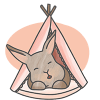 Essentials
Essentials Toys
Toys Accessories
Accessories Goodies
Goodies


